Affiliate disclosure: This post may contain affiliate links. Please see our Privacy Policy.
Self-reliant living starts with re-skilling, and unless you have a mentor handy, there’s no better way than hitting the books. These are my favorite books for self reliant living, and they’re taught me more than I can even begin to express.
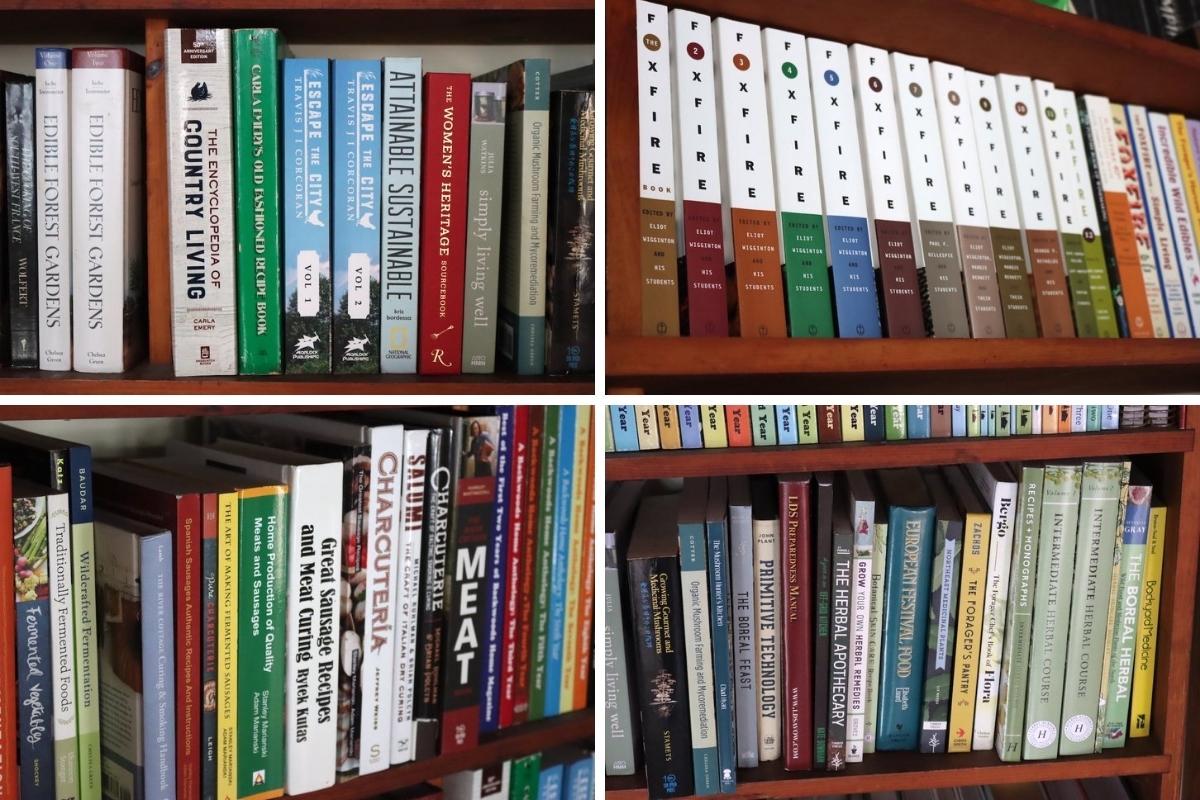
Table of Contents
- Beginner Homesteading Books
- Apartment or Urban Homesteading Books
- Self Reliant Homestead Books
- Scratch Cooking Books
- Bread Making Books
- Gardening Books
- Permaculture Books
- Animal Husbandry Books
- Beekeeping Books
- General Food Preservation
- Canning Books
- Fermenting Books
- Charcuterie Books
- Cheesemaking
- Dehydrating Books
- Homebrewing Books
- Winemaking (& Mead Making) Books
- Herbalism Books
- Foraging and Wild Food
- Mushroom Books
- Homestead DIY and Craft Books
- Metalworking & Blacksmithing
- Home Building & Carpentry Books
- Off-Grid Living Books
- Alternative Energy Books
- Hunting, Fishing, and Survival Skills
- Firearms and Ammunition
- HAM Radio
- Preparedness
- Books for Self Reliance
I’m often asked how I learned to live as we do, foraging food, canning everything in sight, and maintaining a solar-powered homestead.
Did you grow up like that? Are you a 7th generation homesteader?
The answer is…definitely no.
I grew up in southern California, raised by parents who are honestly more than a little disturbed by our lifestyle.
Though I wasn’t born into it, I’m a voracious reader…and once I’m interested in something I seek out every resource I can find to learn everything I can about a topic.
I’m going to give you a peek into my homestead library, and take you through all my favorite books and resources, broken down by topic.
Yes I’ve read them…all of them, and hundreds more. These are by far the most useful books if you’re trying to re-skill, of the literally thousands we have on our shelves.
(Don’t worry, they’re all related to self reliant living, and I’ll skip my extensive collection of Icelandic Cookbooks…)
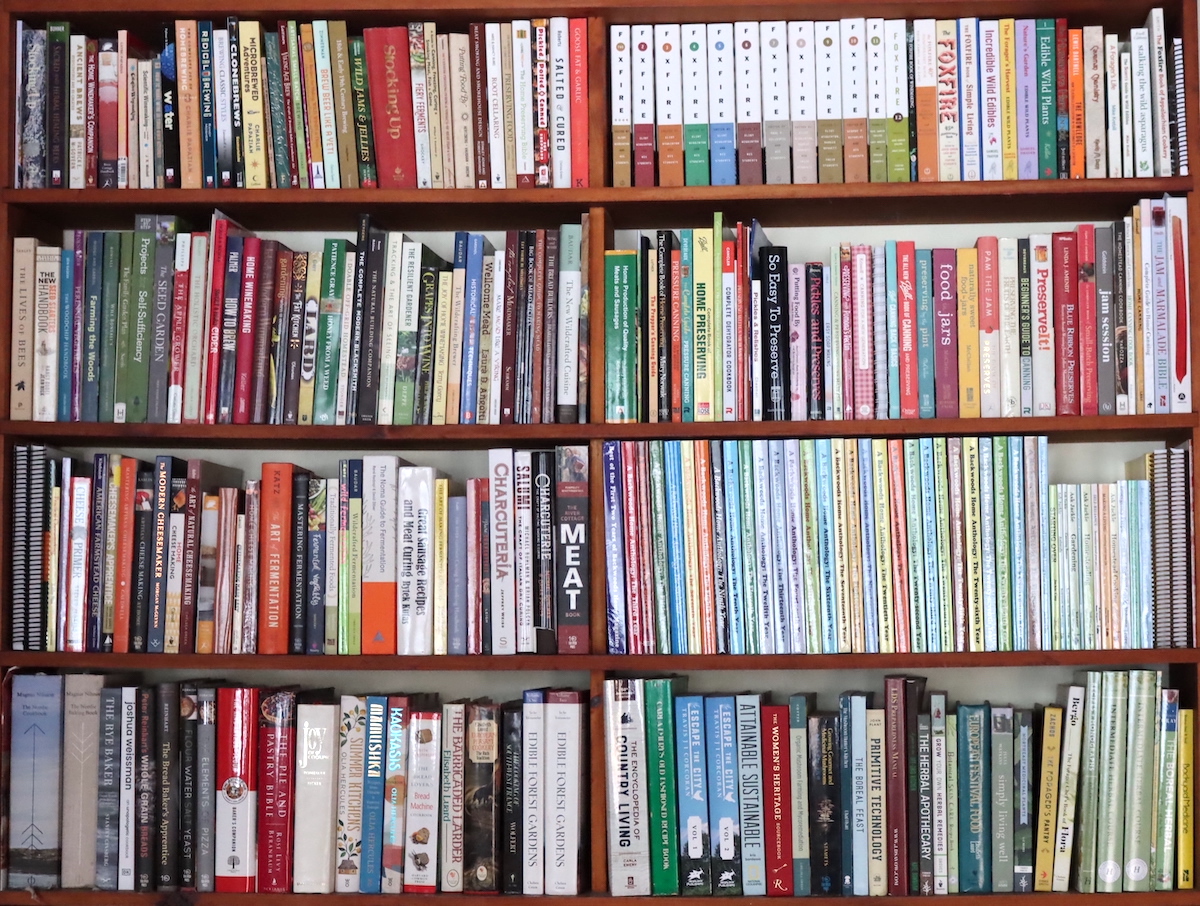
If you’re only interested in specific topics, no problem!
The list of topics is below, and you can click on any of the links to jump to that section of the post.
- Beginner Homesteading Books
- Apartment or Urban Homesteading Books
- Self-Reliant Homesteading Books
- Scratch Cooking Books
- Bread Making Books
- Gardening Books
- Permaculture Books
- Animal Husbandry Books
- Beekeeping Books
- General Food Preservation Books
- Canning Books
- Fermenting Books
- Charcuterie Books
- Meat Preservation
- Cheesemaking Books
- Dehydrating Books
- Homebrewing Books
- Winemaking (& Mead Making) Books
- Herbalism Books
- Foraging and Wild Food Books
- Mushroom Books
- Homestead DIY and Craft Books
- Metalworking and Blacksmithing
- Home Building and Carpentry Books
- Off-Grid Living Books
- Alternative Energy Books
- Hunting, Fishing and Survival Skills Books
- Firearms and Ammunition Books
- HAM Radio Books
- Preparedness Books
Beginner Homesteading Books
For those of you just dipping your toe into homesteading, these beginner homesteading books are a great place to start. They don’t dive deep into any particular topic, but instead give you an overview that’ll allow you do do a little bit of everything.
Want to be more self reliant and don’t know where to start? This is the place.
- Attainable Sustainable: The Lost Art of Self Reliant Living by Kris Bordessa ~ With a page or two on just about everything, this book allows you to dip your toe into everything from composting to beekeeping to foraging and more. Learn how to make sourdough bread, kombucha, elderberry syrup, beginner cheese making, and dozens of other simple homestead projects. By far the best resource for absolute beginners.
- Encyclopedia of Country Living by Carla Emery ~ At nearly 1,000 pages long, this truly is an encyclopedia of living off the land and doing it yourself. She covers everything from raising animals to making soap to handspinning fiber and making jams, jellies and preserves. It’s a little bit of everything, and it’s told in a conversational tone, as if you’re great-grandmother was narrating instructions to pass on everything she’s every done to provide for the family. Since it covers so much, it’s a little less approachable than the Attainable Sustainable book, but it’s an excellent resource for anything homesteading.
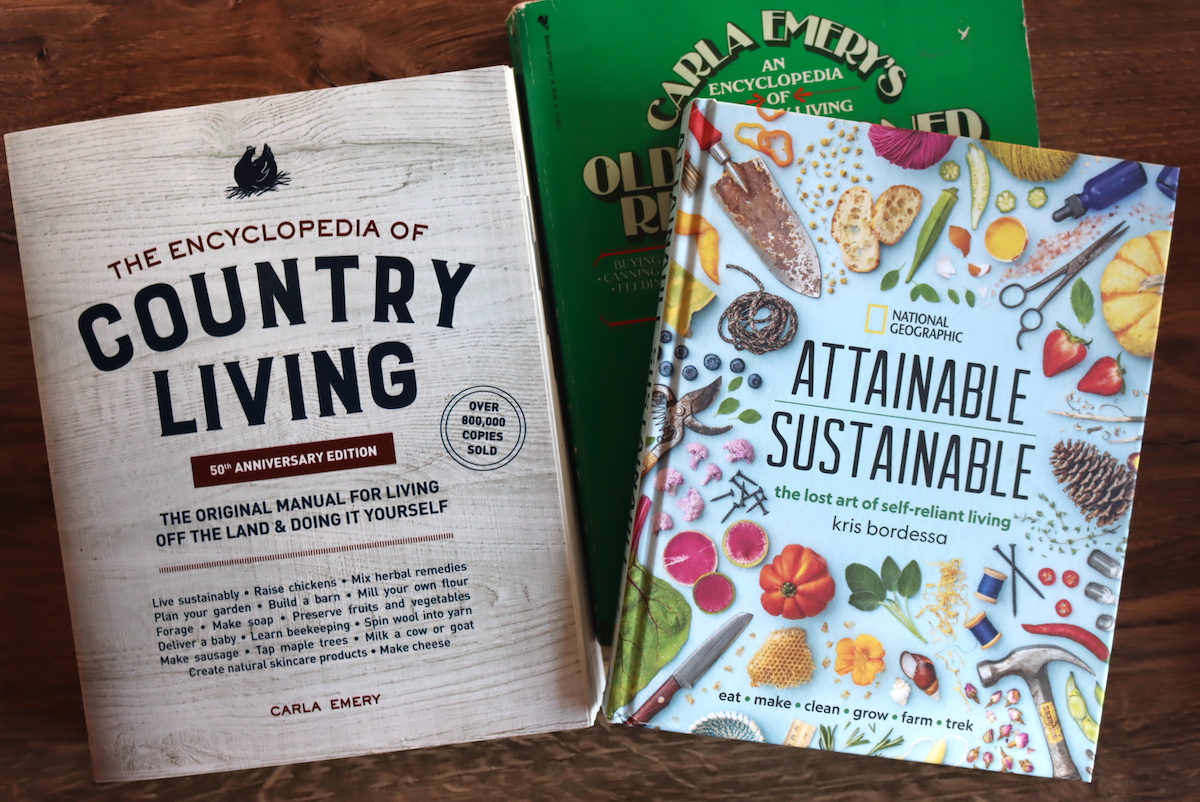
Apartment or Urban Homesteading Books
Not everyone’s going to move to land out in the country, and many people are just looking for a way to incorporate small DIY projects into their routine.
Simple herbal remedies, homemade cleaning products, from scratch bread and maybe a few canning recipes.
These books have plenty of projects to get you started, and they’re perfect gifts for someone just starting on the DIY lifestyle.
- The Women’s Heritage Source Book: Bringing Homesteading to Everyday Life ~ Assembled by multiple women who all incorporate homesteading into their daily lives, be it in an apartment or small suburban “farms.”
- Simply Living Well: A Guide to Creating a Natural Low Waste Home by Julia Watkins ~ With dozens of simple DIY recipes for herbal remedies and natural cleaning products, this book is artfully presented and inspiring.
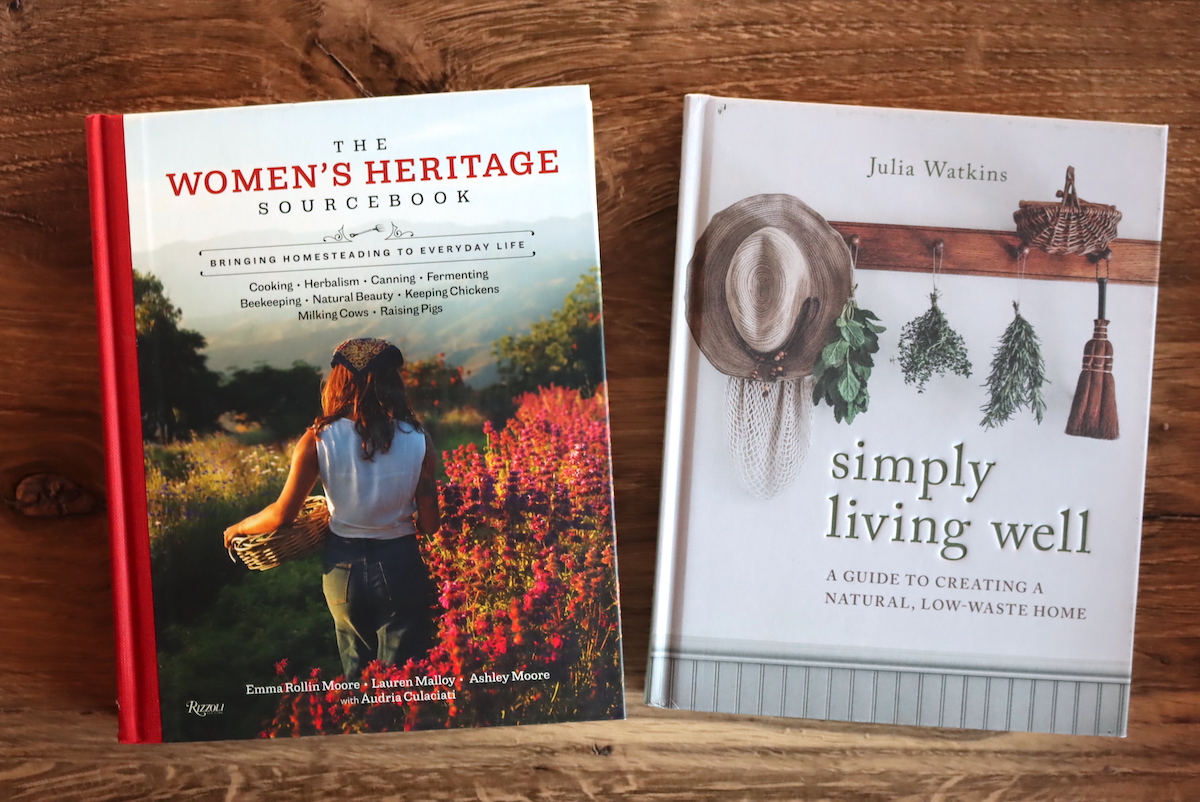
Self Reliant Homestead Books
Looking to do more than dip your toe into homesteading?
These manuals take a deeper dive into self reliant living, covering just about everything you’d need to know to move to land and provide for yourself.
- Essential Guide to Radical Self Reliant Gardening by Will Bonsall ~ This is technically a “gardening” book, but it covers so much more than that. Will Bonsall and his family strive to produce everything they need on their homestead in Maine, with minimal external inputs. They even grow their own seed oil. The guy is quite a character, and if I had to choose one book that really covers living off the land on a homestead, this would be it. Truly one of my favorites.
- Escape the City: A How To Homesteading Guide (Volume 1 & 2) by Travis Corcoran ~ He describes EXACTLY how to set up a self reliant homestead on new land, literally step by step, down to each and every tool he uses. Cost guides, plans for everything…in more than 1,300 pages across two volumes. It’s a dense read, but he’s really created an incredible guide to “escaping the city” to live on the land for people that have never even picked up a shovel in their lives.
The books above are straightforward and to the point, and though I’m 15+ years into homesteading I still learned quite a lot from them.
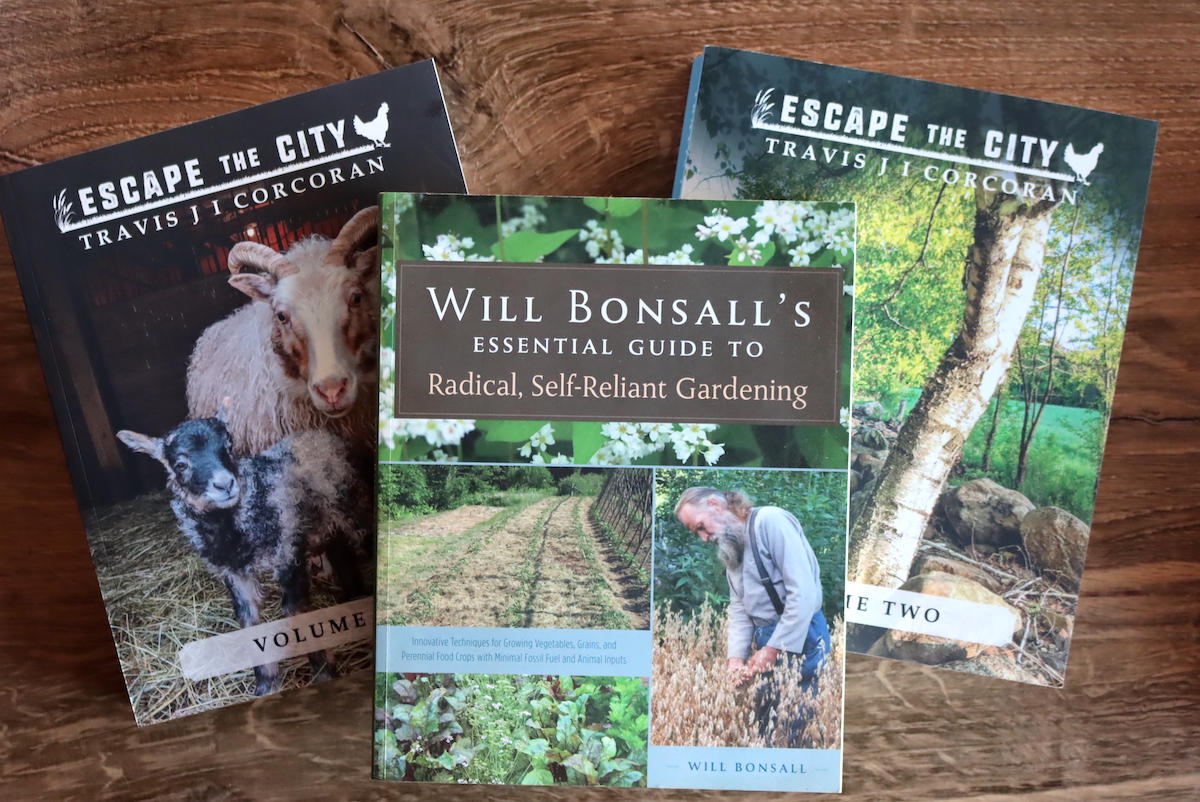
For more of the casual reader, that’s willing to learn the history and lore alongside the straightforward “DIY” manuals, I’d also recommend the book series below.
They’re quite a bit longer, and at 12+ volumes each, they’ll take up a lot more space on your bookshelf. They’re none the less incredibly informative and engaging reads, and the perfect thing to casually read each morning with your coffee.
- Foxfire Books ~ For over 40 years students interviewed homesteaders in Appalachia and learned their way of life. These books include everything from how to slaughter a hog to glazing homemade pottery with wood ash, and thousands of other things. They also include a lot of heritage, old stories, superstition, music and folklore.
- Backwoods Home Anthologies ~ These are books compiling all the articles from the last 30 years of backwoods home magazine. Every one contains detailed DIY tutorials on every homesteading topic, in an easy to read conversational manner. It’s an investment for all of them, but I pick these up and flip through them at some point nearly every week.
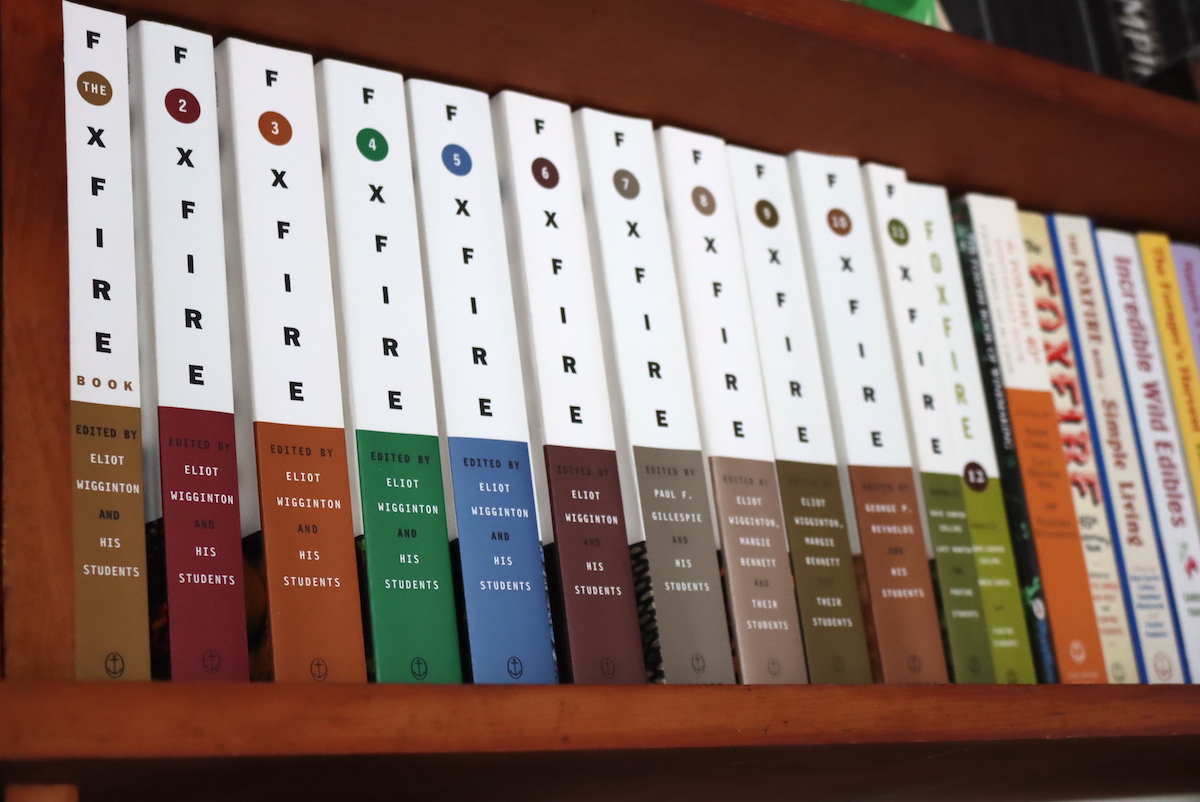
Scratch Cooking Books
Even if you’ve never cooked before in your life, these books really cover just about everything you could want to know about making meals from scratch.
If you only choose one, definitely go with the Joy of Cooking.
- Joy of Cooking – Over 1,000 pages with basic recipes for almost everything under the sun. It’s a lot more than just pancake recipes, and the authors cover every meal and just about every type of food (pickles, roasts, pasta dishes and more). The old editions (1970’s and before) even have instructions for cooking possum and beef lung, things that were once common enough but you won’t find these days. The modern versions are just as comprehensive, but obviously choose foods based on modern tastes and availability.
- King Arthur Flour Baker’s Companion ~ Nearly as long as they Joy of Cooking, but focusing on just foods made from scratch with flour. Literally any type of bread, baked good, tortillas, whatever you can think of. Flour keeps almost forever, and learning to craft diverse meals from your long term storage food is a great way to rely on your pantry (rather than always running to the grocery store).
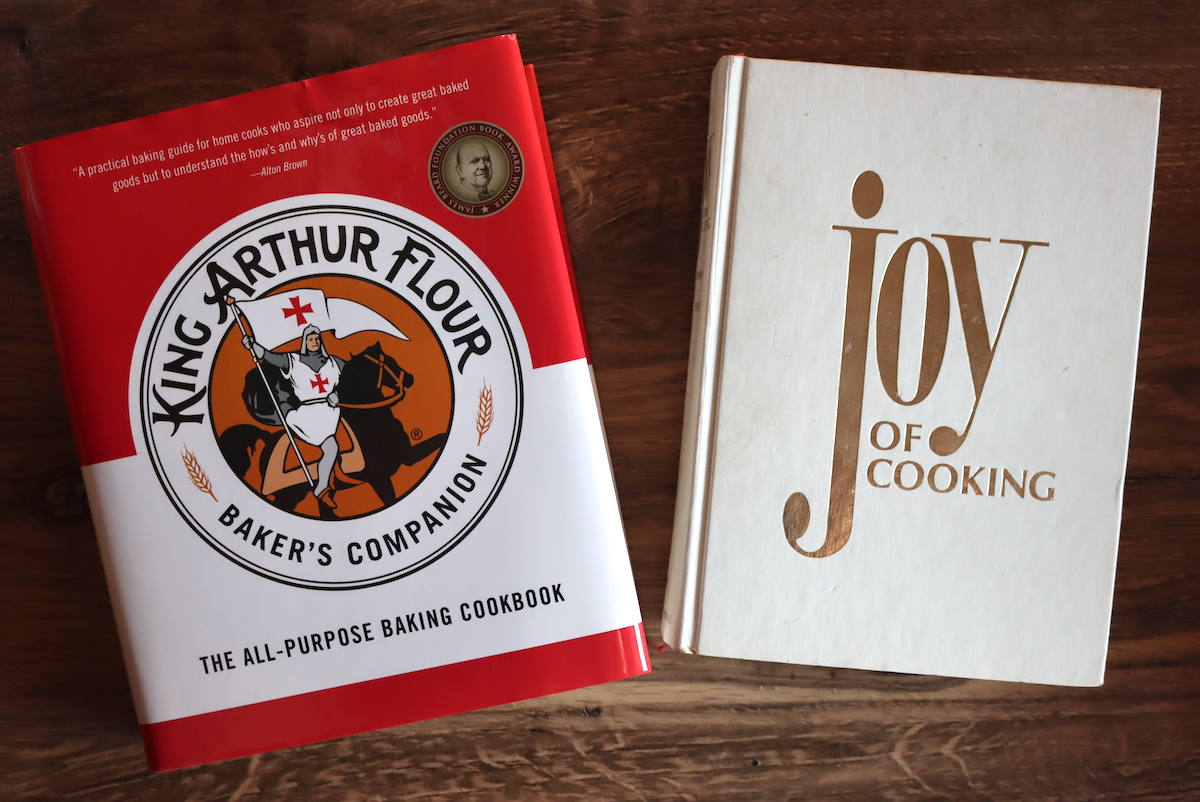
Bread Making Books
Making homemade bread is simple, but once you move beyond sandwich loaves and into artisan bread it can get complicated quick.
We make a lot of bread here on our homestead, a lot more than just loaves of our favorite sandwich milk bread. From complicated multi day slow fermented loaves to quick no knead crusty sourdough, these bread making books will take you through the art of homemade bread (and pizza too).
- Flour Water Salt Yeast by Ken Forkish ~ The best guide I’ve found to making simple artisan bread. He incorporates a lot of no-knead type processes, combined with long, slow yeast based fermentation to develop flavor in the dough. Perfect crisp crust every time!
- The Bread Bakers Apprentice by Peter Reinhart ~ A bit more finicky, this one takes you through the exact process for making traditional breads from around the world. Most recipes require slow 2-3 day ferments, as the dough is slowly conditioned. It’s mostly hands off, but a lot more involved than the no knead recipes in Flour Water Salt Yeast.
- Whole Grain Breads by Peter Reinhart ~ The best guide on making 100% whole wheat bread taste amazing. Again, as with the Breadbakers Apprentice, most of the recipes involve multi day ferments, but that’s really essential to high quality whole grain breads.
- Sourdough School by Vanessa Kimbell ~ A great beginners guide to working with sourdough. The books above are all yeast based breads, and this one is all sourdough.
If you’re a beginning bread maker looking for the simplest possible process, you can always get a bread maker and try your hand at bread machine recipes.
My favorite bread machine cookbook is The Bread Lovers Bread Machine Cookbook, which has every recipe you could ever want for your machine.
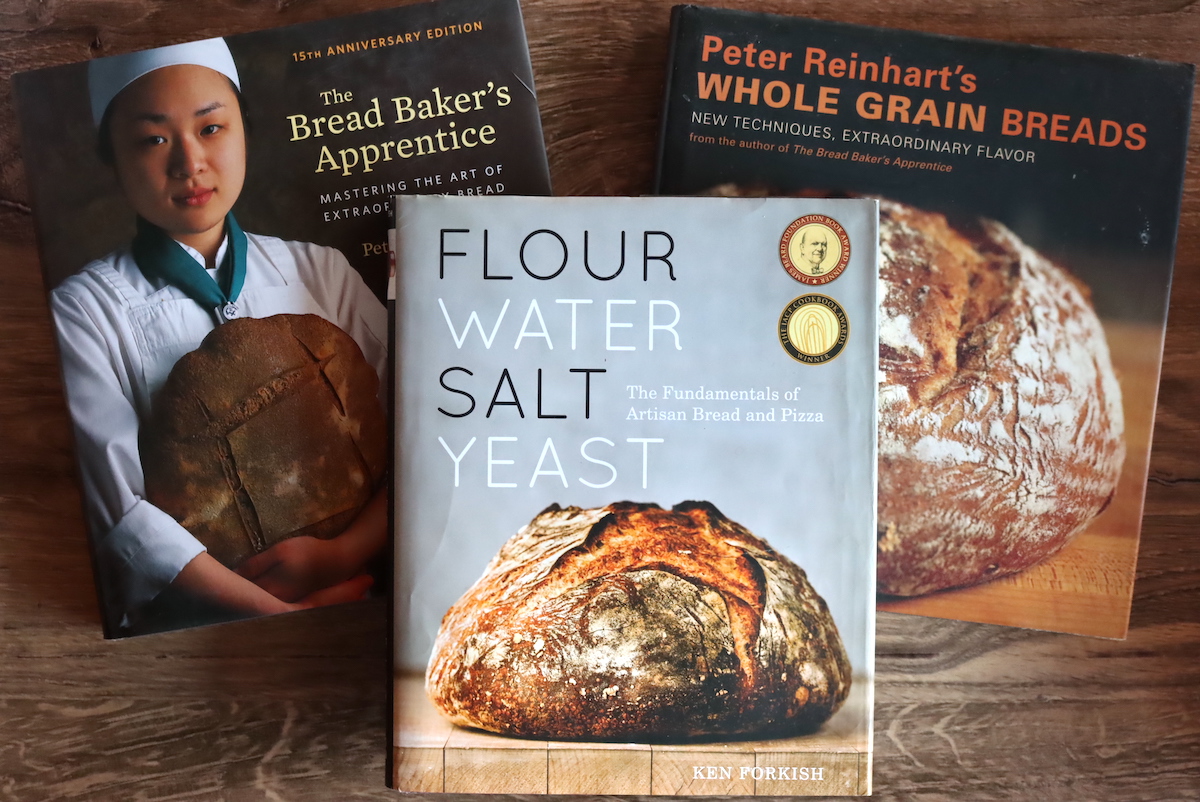
Gardening Books
Gardening is a lot more complicated than sticking seeds in the ground and hoping they’ll grow, especially if you hope to harvest a meaningful amount of food from your own land.
These are near my bed all summer long as I plan, grow and harvest our food here on the homestead.
- The Vegetable Gardener’s Bible by Edward Smith ~ The name says it all, this is the perfect beginner vegetable gardening book. Our local librarian handed it to me one day when she saw me in the gardening section, and laughed saying, “This is my favorite…but I’m biased, it was written by my husband.” Biased or not, she got me to open it and it really is a great resource.
- The Family Garden Plan by Melissa K Norris ~ If your hope is to grow a significant portion of your own food in your home garden, this is the book to help you plan it.
- The New Seed-Starters Handbook by Nancy Bubel ~ A comprehensive manual on growing anything (and everything) from seed. At around 450 pages, you wouldn’t think there’d be that much to learn about seed starting, but you’d be wrong!
- Fresh Food from Small Spaces by RJ Ruppenthal ~ An incredible (and creative) guide to getting the most out of incredibly small garden spaces. As small scale as literally countertop gardening by growing microgreens in your kitchen, up to converting your back patio to produce food, all the way up to a small suburban lot. You’d be amazed at how much food you can produce in literally a few feet of space.
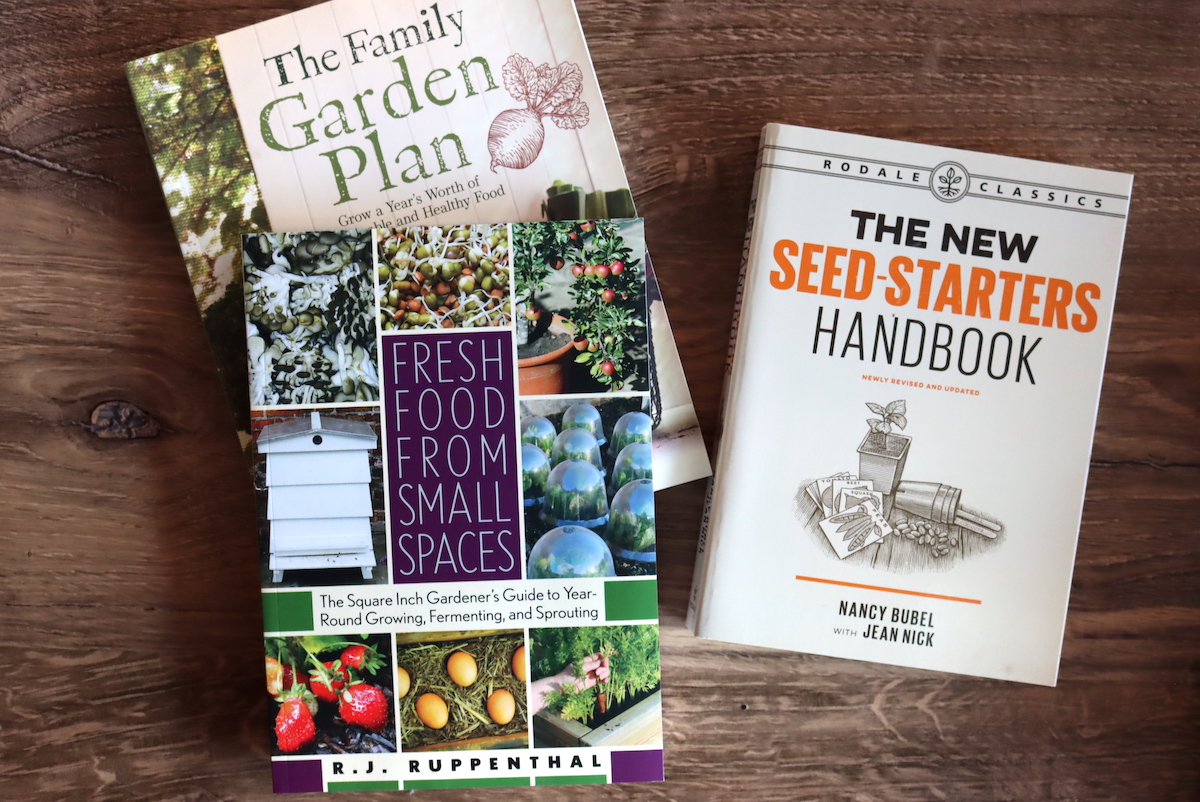
The books below are for more hardcore gardening, rather than a just casual interest. They happen to be my favorites, and they’re some of the most useful for self reliance.
- The Resilient Gardener: Food Production and Self Reliance in Uncertain Times by Carol Deppe ~ Carol is a seed breeder and home gardener that grows an impressive variety of food crops to supply the bulk of her daily calories. If you really want to grow calories, not just fancy lettuce, she has a great guide.
- Gardening When it Counts: Growing Food in Hard Times by Steve Solomon ~ The author is the founder of Territorial Seed Company, which he started after he began growing most of his of his own food in his backyard. Less by choice, and more by necessity since he was unemployed and broke. He talks you through everything you need to know to grow a substantial portion of your own food without outside inputs, whether you’re gardening because you’re broke…or it’s the apocalypse.
- Essential Guide to Radical Self Reliant Gardening by Will Bonsall ~ This is one of my favorite books, and I’ve already mentioned it twice before. Still, it’s one of the best gardening guides for homesteaders that intend to provide much of their own food, so it bares mentioning again.
- The Seed Garden by The Seed Savers Exchange ~ There are a lot of books on seed saving, and I have many of them, but this is by far the best single volume on the topic.
- The Humanure Handbook by Joseph Jenkins ~ Not a topic that most people want to discuss, but if you truly want to “close the loop” and harvest abundant crops from your own land without outside inputs, then it’s important to look to yourself as a source of fertility. This discusses every aspect of humanure in an accessible and easy to implement way.
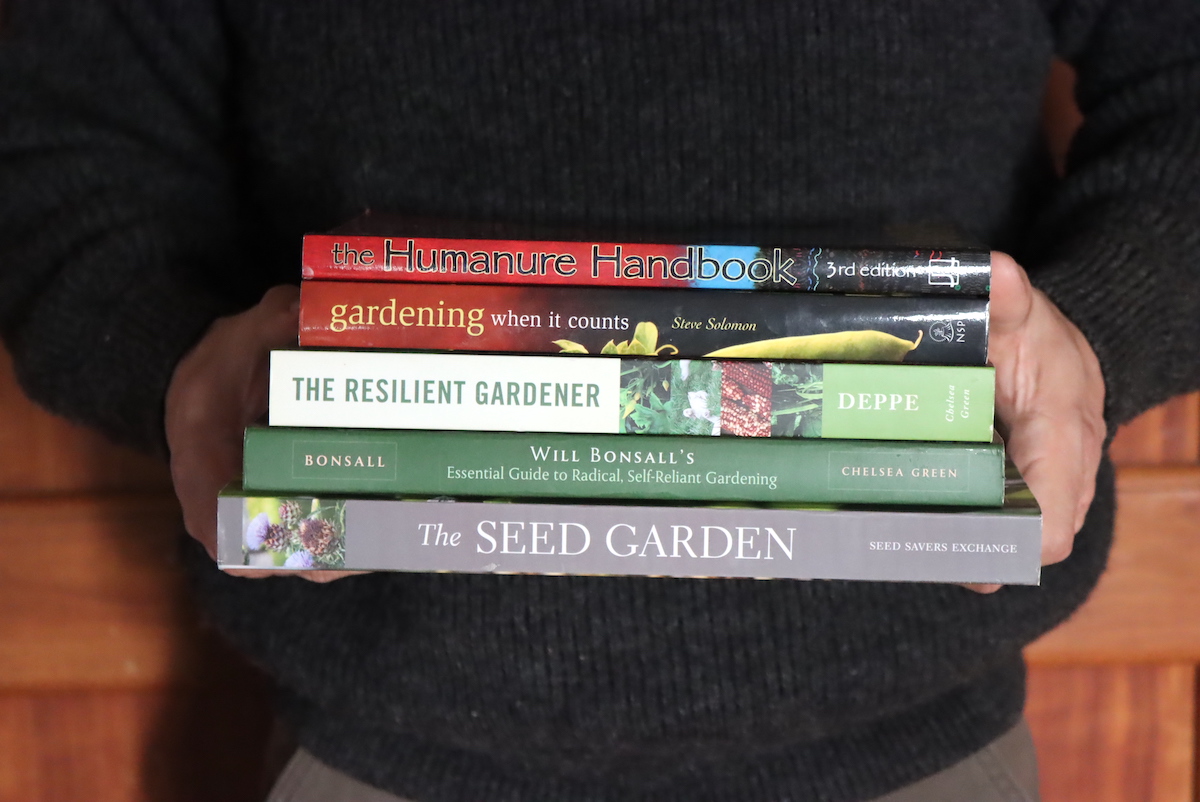
Permaculture Books
If you’re specifically interested in Permaculture, I have a separate article covering the best permaculture books and why I love each one.
Here are my favorites:
- Farming The Woods by Kevin Mudge and Steve Gabriel ~ Though it’s not technically a “permaculture” book in the strict sense, this book was by far the most helpful for turning our 30 acres of woodland homestead into productive use. It covers mushrooms, shade tolerant berries and vegetables, woodland medicinal like ginseng. This is where we learned how to grow ramps (wild leeks).
- Edible Forest Gardens (Volume 1 & 2) ~ The original handbooks for permaculture, these are a dense read but cover everything you need to know.
- The Permaculture Handbook by Peter Bane ~ Also covers most of what you’d need to know to get started, but brings it to life with practical examples and a more accessible writing style than edible forest gardens.
- The Suburban Micro-Farm by Amy Stross ~ A small scale guide to backyard permaculture.
- Perennial Vegetables by Eric Toensmeier ~ Covering more than 100 types of perennial vegetable, this will really open your eyes to unique food crops that you can plant once and harvest for a lifetime. We grow more than 30 Perennial Vegetables on our homestead, even though we’re in a cold zone 4, and it’s thanks to this book.
- Tree Crops: A Permanent Agriculture by J. Russell Smith ~ Written in 1928, this is one of the very first “Permaculture” books, long before permaculture was even a word. It really takes you through the process of investing in tree crops rather than annuals, as well as how to incorporate animals into a silviculture setup.
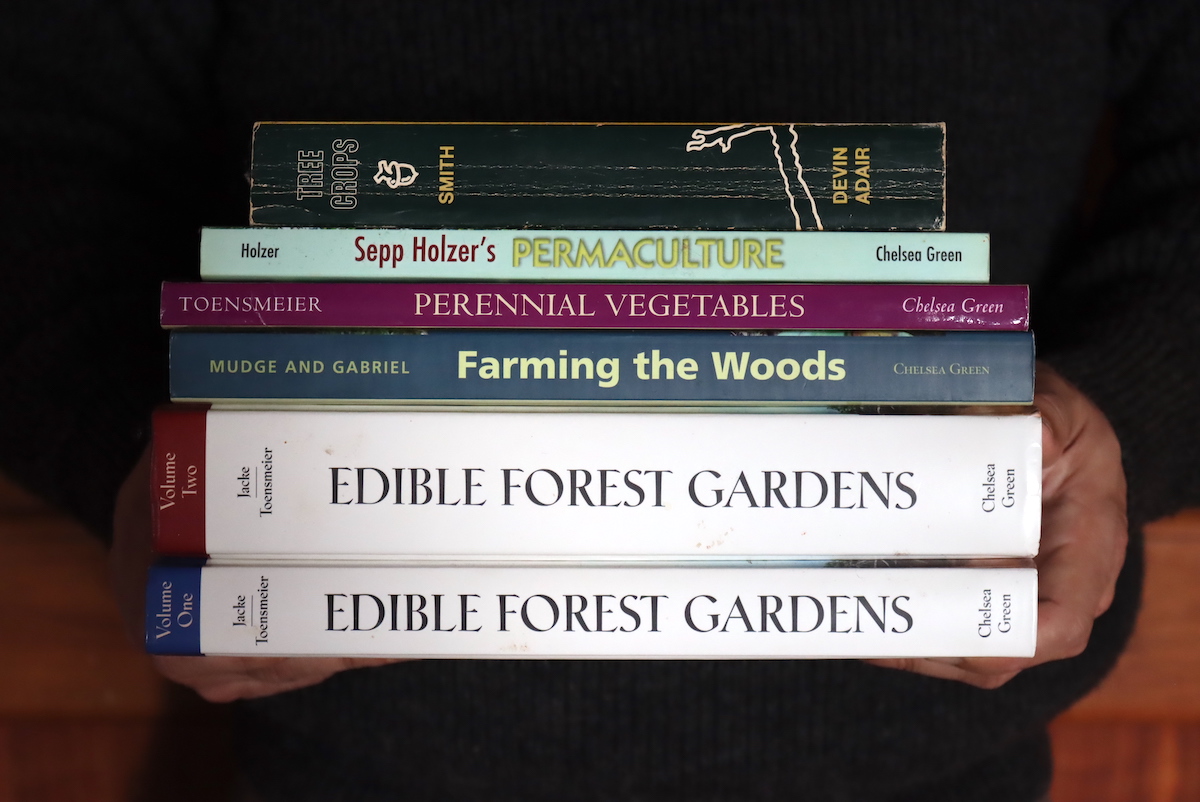
Animal Husbandry Books
The tricky part about animal husbandry books is that every animal has very different requirements. There’s no one book that covers all you need to know about keeping every type of homestead animal, even if you just limit yourselves to the common ones (chickens, cows, pigs, etc).
What I’d suggest instead is getting a specific book on each type of animal you hope to raise. We especially love the Story Guides Series, which does have specific and comprehensive books on just about every type of livestock.
- Storey Guide to Raising Chickens
- Storey Guide to Raising Ducks
- Story Guide to Raising Pigs
- Story Guide to Raising Sheep
- Storey Guide to Raising Dairy Goats
- Storey Guide to Raising Meat Goats
- Storey Guide to Raising Beef Cattle
- Storey Guide to Raising Rabbits
Beyond the story guides, I’d also specifically call out The Homesteader’s Natural Chicken Keeping Handbook by Amy Fewell.
I especially love that she covers natural remedies for common chicken issues, like a homemade anti-fungal salve for chickens that’s made with wild foraged black walnut hulls. A good resource for natural, low input chicken keeping that will allow you to provide for your flock on your own, without constantly buying supplies.
Beekeeping Books
We’ve raised a lot of animals over the years, but by far my favorite creature to tend was always the bees.
There’s something meditative about working bees. Some days I’d just pull up a chair a few yards from the hive entrance and just watch the ladies about their work, streaming in and out of the hive loaded down with pollen and nectar.
Beekeeping is particularly intimidating to beginning homesteaders, and while chickens may be the gateway animal, bees are pretty far down on most people’s priority list. It’s a shame because they’re really not that hard to raise if you read up on the topic before you get started, and they’re my personal favorite.
- Natural Beekeeping: Organic Approaches to Modern Apiculture by Ross Conrad ~ By far, the best beekeeping book I’ve read to date, especially for organic and treatment free beekeepers.
- The Lives of Bees: The Untold Story of the Honeybee in the Wild by Thomas Seeley ~ This is not a beekeeping manual, but rather a natural history book that discusses how bees live in the wild. None the less, it’s been by far the most useful beekeeping book on my shelf. It has allowed me to understand what bees really want/need and how to tend them in a natural, treatment free way that’s closest to their wild habitat.
General Food Preservation
Most food preservation books cover a single topic in depth, rather than the subject of food preservation in general. It’s easy enough to find canning books, or fermenting books, or dehydrator books…but general manuals that cover all manner of food preservation techniques are much less common.
Still, I’ve found quite a few over the years that are incredibly useful and comprehensive.
- The Home Preserving Bible by Carol Cancler ~ A good general purpose preserving book that covers multiple methods of food preservation (canning, freezing, dehydrating, etc).
- Stocking Up by Carol Hupping ~ I absolutely love this book and I own several editions. It covers a lot of food preservation techniques that are hard to find these days, like water glassing eggs and small scale root cellars.
- Preserving Food without Freezing or Canning ~ A truly incredible resource with historical food preservation techniques that are still practiced in Europe today. I’ve made many of their recipes, including preserving cheese in wood ash, and they always turn out well.
- Root Cellaring by Mike and Nancy Bubel ~ Thought its specifically about root cellaring, whether in an actual root cellar or just creating a root cellar like space in your home or apartment, this is an excellent guide for how to store produce in general.
- Pickled, Potted and Canned by Sue Shephard ~ Though it’s not a recipe book, or even a how to book, this is by far my favorite food preservation book. It’s a history book that takes you through the progression of food preservation technology, including historical food preservation techniques you’ve probably never heard of. I find it incredibly fascinating, and I’ve read through it front to back at least 5 times.
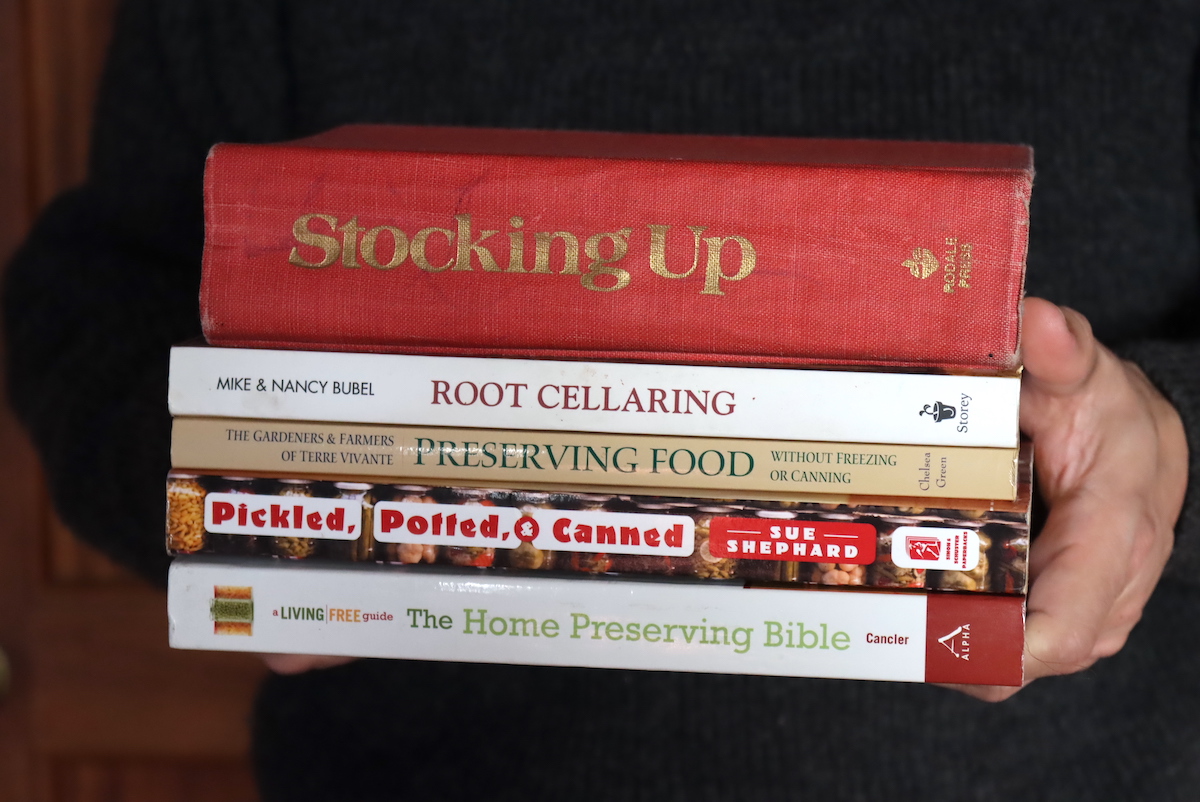
Canning Books
I’m a bit obsessed with canning recipe books, and I have literally dozens of books on all aspects of home canning. Specialized books that cover how to make jam and preserves, as well as books that go through hundreds of different pressure canning recipes.
These are my absolute favorite canning books, and the perfect start to a home canning library.
- The Ball Complete Book of Home Preserving ~ With over 400 recipes, this book covers how to can almost everything. If you only get one canning book, this is the one. My only criticism is the jam recipes are very high sugar, and don’t give a lot of options for low or moderate sugar recipes.
- Ball Canning Back to Basics ~ Fewer recipes than the “complete” book, but all the most useful ones. More of a curated canning guide, with recipes updated to more modern tastes (less sugar).
- The Complete Guide to Home Canning by The US Department of Agriculture ~ This is a printed version of the National Center for Food Preservation‘s website, with tested canning guides and tables. Incredibly handy, especially if you have spotty internet.
- Canning for a New Generation by Liana Krissoff ~ Really inventive recipes with unique flavors, truly not your grandmas cookbook (in a good way).
- So Easy to Preserve by The Georgia University Extension ~ A really comprehensive guide to all the state/nationally tested canning recipes, including some that are just not available anywhere else. More comprehensive than the “complete” guide listed above. Hard to find online, but sometimes it’s available used.
- Pressure Canning for Beginners and Beyond by Angi Schneider ~ Hands down the best pressure canning guide book available, with really creative recipes as well as old favorites.
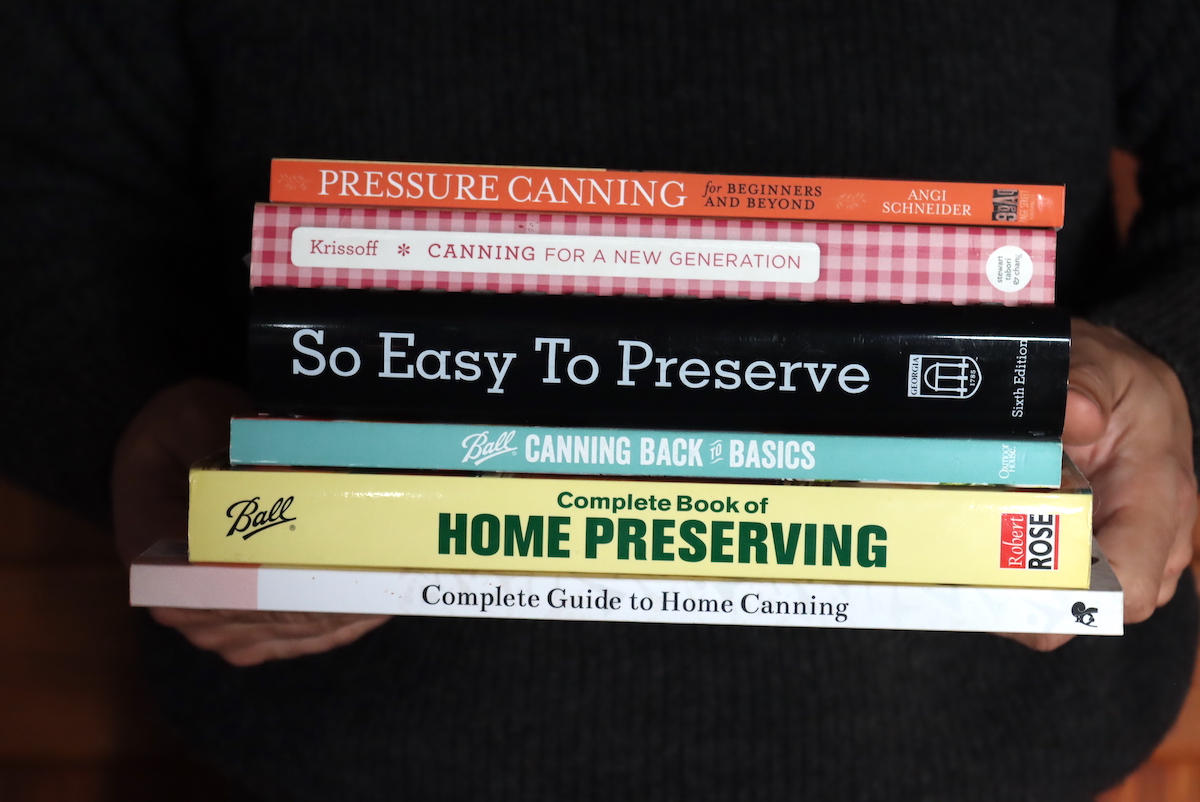
Beyond these general canning manuals, I’d also recommend a number of specific canning books that cover mostly water bath canning recipes for jams and preserves:
- Food in Jars: Preserving in Small Batches Year Round ~Inventive small batch recipes.
- The Jam and Marmalade Bible ~ Written using the European school of preservation. Less a “canning” book, and more a really detailed technique book for making spectacular preserves.
- Preserving with Pomona’s Pectin ~ A specific guide to working with pomonas “low sugar or no sugar” pectin. A great resource if you’re avoiding processed sugar.
- Naturally Sweet Food in Jars ~ Canning recipes using maple, honey, agave and coconut sugar instead of refined white sugar.
Fermenting Books
Lacto-fermentation has been around for centuries as a traditional food preservation technique, and it’s just coming back into fashion as people realize the benefits of probiotic foods.
Traditional cultured foods go much beyond yogurt, homemade sauerkraut, and lacto-fermented pickles. There are literally hundreds of ways to preserve food through probiotic fermentation.
(I’m just covering lacto-fermentation books here, I’ll cover home brew beer and wine making books separately later on.)
- Wild Fermentation by Sandor Ellix Katz ~ The initial guide that started the modern fermented food revolution. There’s a lot of discussion covering the benefits of fermented food, as they were still uncommon on modern tables when this was written.
- The Art of Fermentation by Sandor Elix Katz ~ A second, much more comprehensive fermentation guide book covering traditional ferments from around the world. This one was written 10 years later, and is an even better resource than the original in my opinion. Covering less common fermentation styles like water kefir, mesophilic yogurts, ginger bugs and other things far beyond fermented veggies.
- Mastering Fermentation by Mary Karlin ~ Perhaps the most accessible beginners fermenting recipe book, this book contains detailed recipes (and beautiful pictures) of nearly every type of common home ferment, from vegetables to vinegars and cheeses. It’s a great place to start if you’re looking for a recipe book, rather than general theory.
- Fermented Vegetables by Christopher and Kristen Shockey ~ The most definitive guide I’ve found for making lacto-fermented vegetables, including less common recipes (like fermented turmeric) and recipes using wild ingredients (like fermented burdock leaves), as well as all the common garden veggies.
- The Noma Guide to Fermentation ~ Written by the people that run the famous restaurant Noma, this guide has some really detailed high scale fermentation recipes. They can only be described as artisanal, and though it’s a good read for the true fermentation devotee, it’s well beyond what the average person is going to choose to make in their home kitchen. Still an excellent guide if you’re really into fermenting, and I used their artisanal technique for making apple cider vinegar.
- Wildcrafted Fermentation by Pascal Baudar ~ This one’s really specific to wild foraged ingredients, from wild weeds to acorns and other wild harvested ingredients. He ferments them into all manner of dishes, from pickles and preserves to drinks and main courses. A great resource for the forager who also wants to get into fermentation.
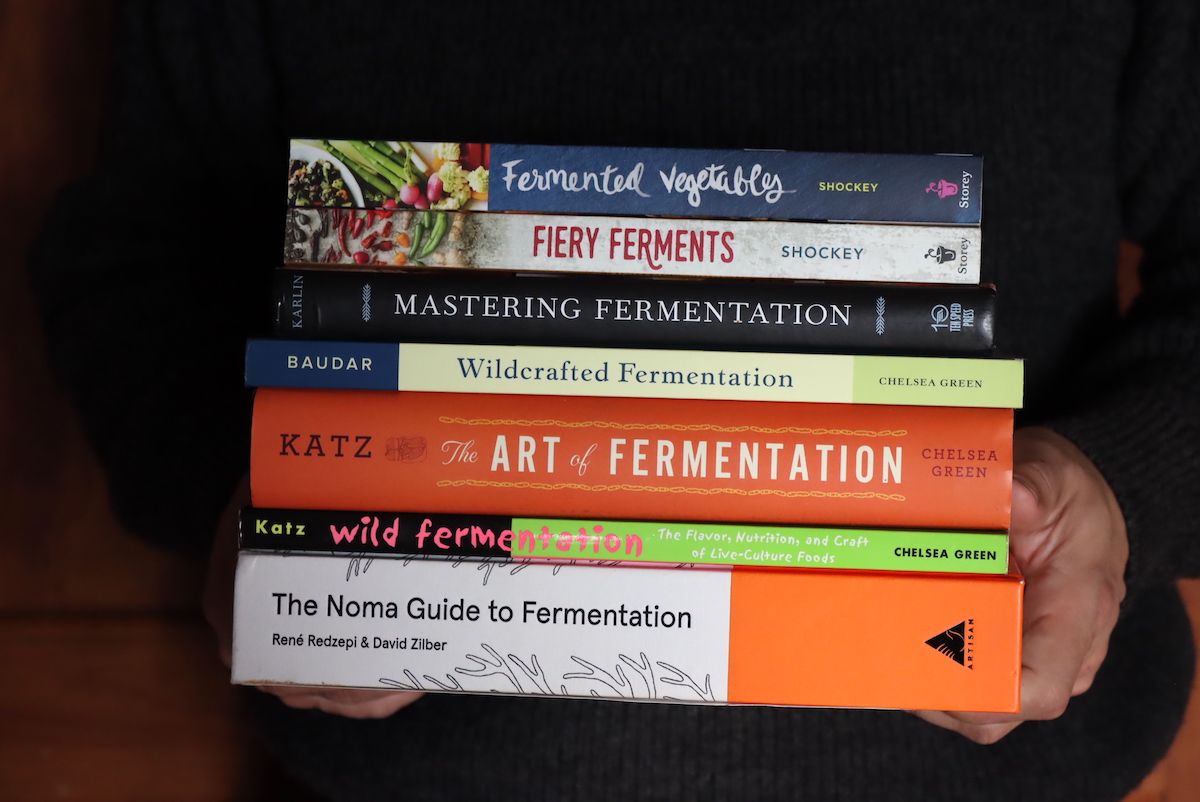
Beyond these specific fermentation guide books, I’d also recommend any of the cookbooks by Olia Hercules. She’s a Ukrainian author and though she writes about Ukrainian cooking, that’s something you just can’t do without covering a lot of home fermentation recipes (and other food preservation topics).
All of her books are spectacular, but for fermenting I’d specifically recommend Summer Kitchens.
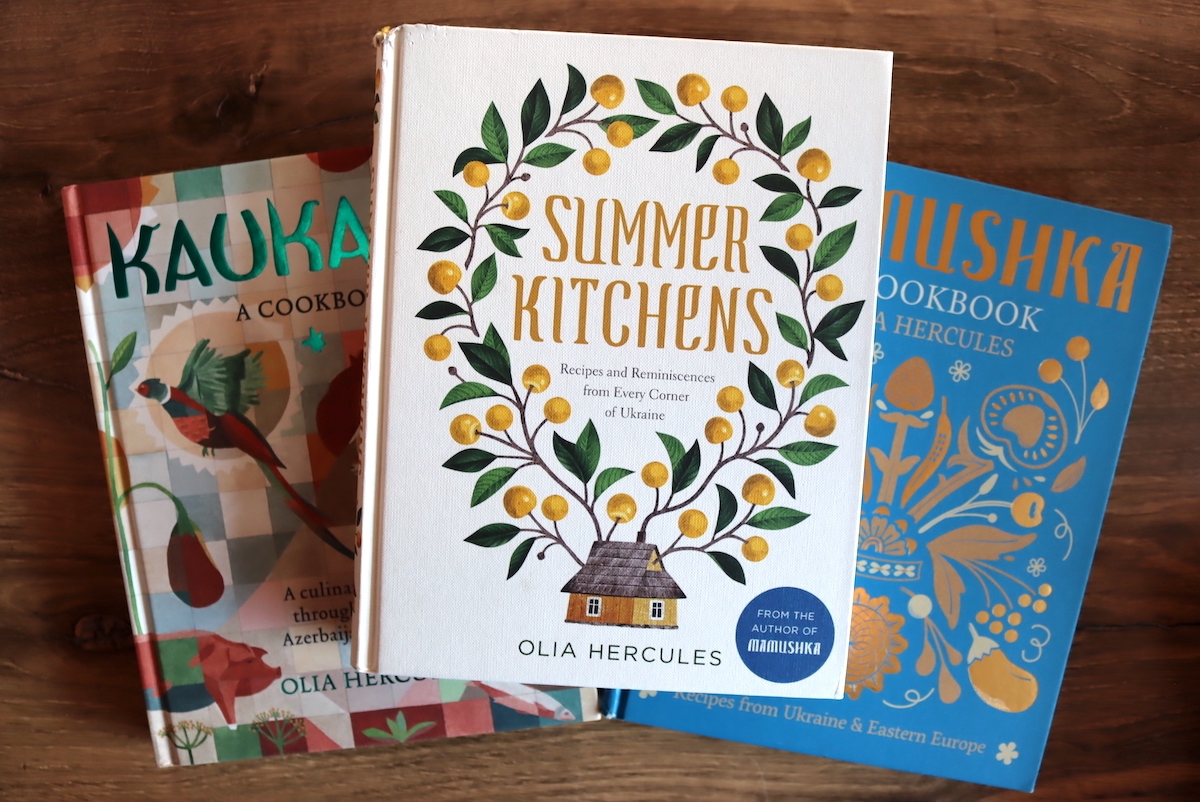
Charcuterie Books
Believe it or not, charcuterie is another form of lacto-fermentation and with a little dedication you can craft your own prosciutto, pancetta and salami at home.
We make quite a few styles of cured meat here on our homestead, handing them to cure in our cool basement.
- Salumi: The Craft of Italian Dry Curing by Michael Ruhlman and Bryan Polcyn ~ Takes you nose to tail through preserving a whole pig with charcuterie, part by part. Recipes, techniques, everything you need to know for an absolute beginner.
- Charcuterie: The Craft of Salting, Smoking and Curing by Michael Ruhlman and Bryan Polcyn ~ While the Salumi book covers Italian charcuterie with just pork, this manual covers more styles and meat types. It’s where I pulled a recipe for duck breast prosciutto.
- The River Cottage Curing and Smoking Handbook ~ A great beginners guide full of simple, easy to follow recipes.
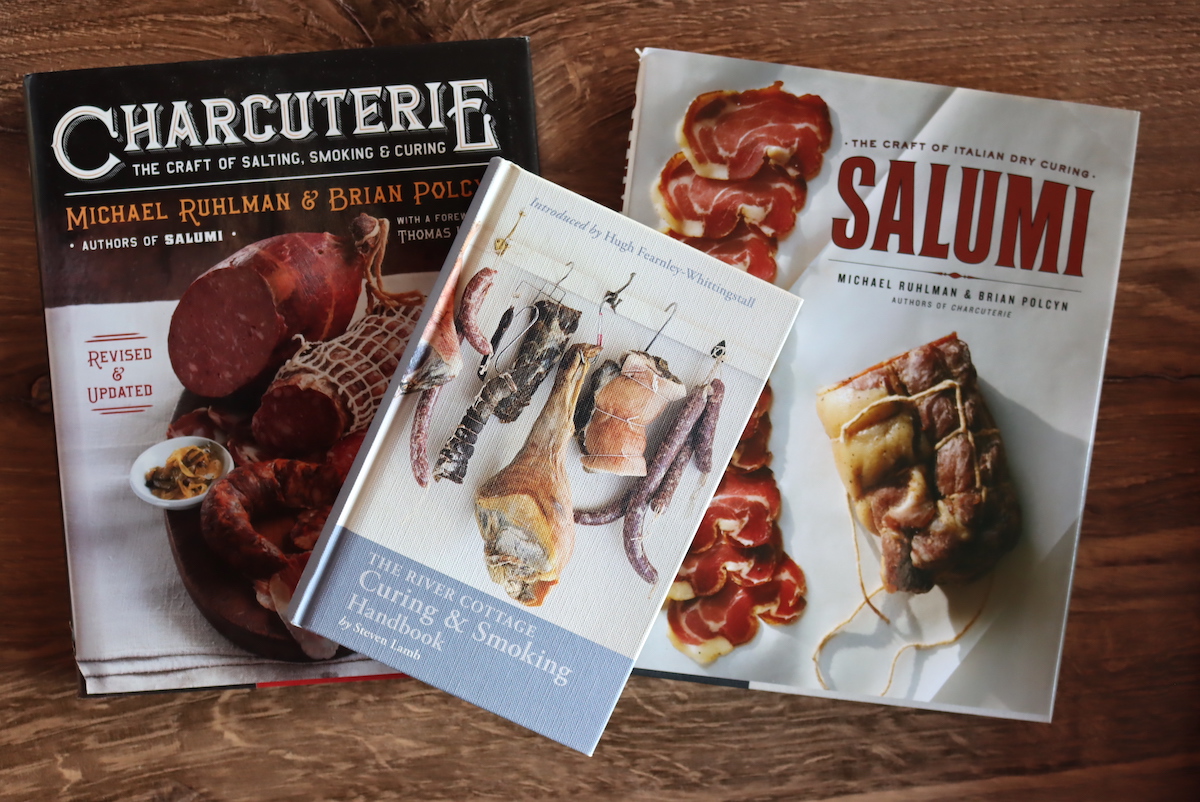
The books above cover most styles of charcuterie, but if you really want to go down the rabbit hole of meat preservation there are more detailed technical manuals as well.
These are not for the casual reader, and I’d really only recommend them if you’re going to get really into making cured meats. None the less, they are incredible manuals for doing just that.
- The Art of Making Fermented Sausages by Stanley and Adam Marianski ~ A detailed technical manual specific to making cured sausages.
- Home Production of Quality Meats and Sausages by Stanley and Adam Marianski ~ The name says it all, and at around 700 pages it’s quite the manual.
- Great Sausage Recipes and Meat Curing by Rytek Kutas ~ Another great technical manual full of literally hundreds of recipes.
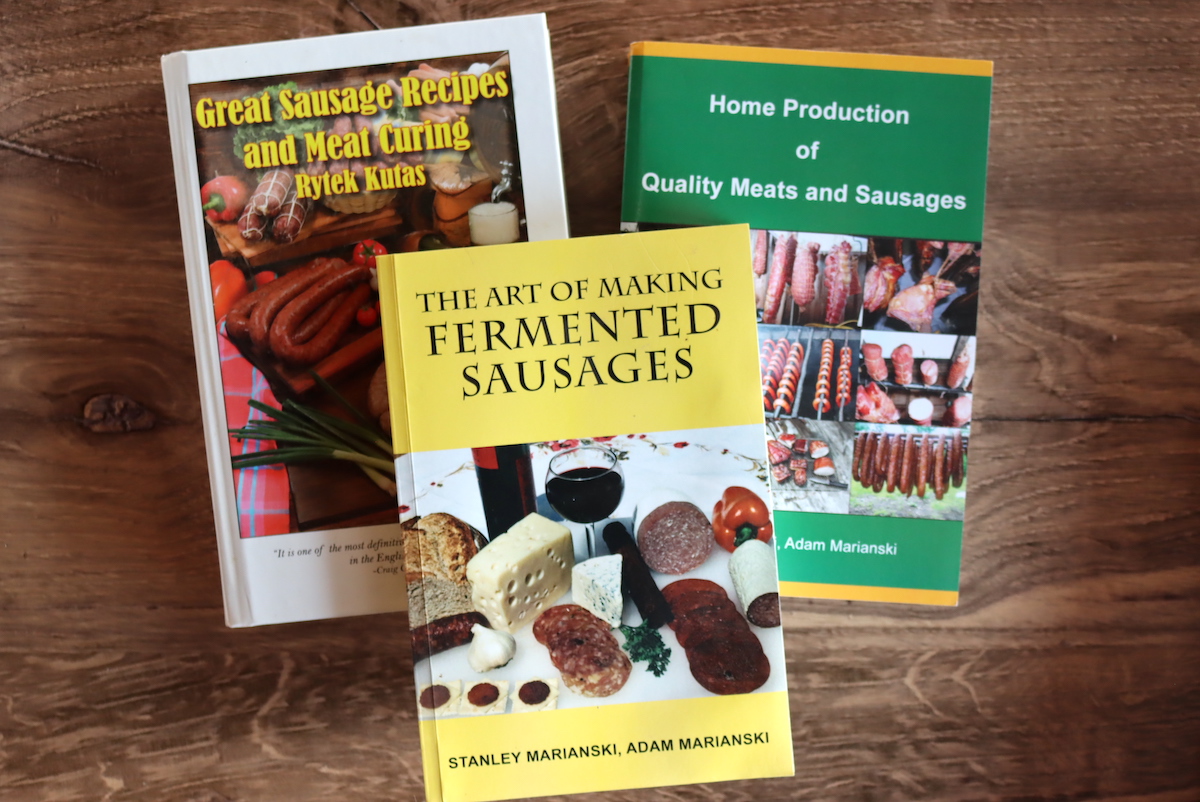
Meat Preservation
If you’d like to get less technical, and don’t necessarily want to dive deep into the craft of charcuterie, then I’d suggest these general meat preservation books.
Some include bits of charcuterie, but mostly they’re discussing other methods (dry aging, smoking, canning meat, etc).
- A Guide to Canning, Freezing, Curing & Smoking Meat, Fish & Game
- The River Cottage Meat Book
- Meat Smoking and Smokehouse Design
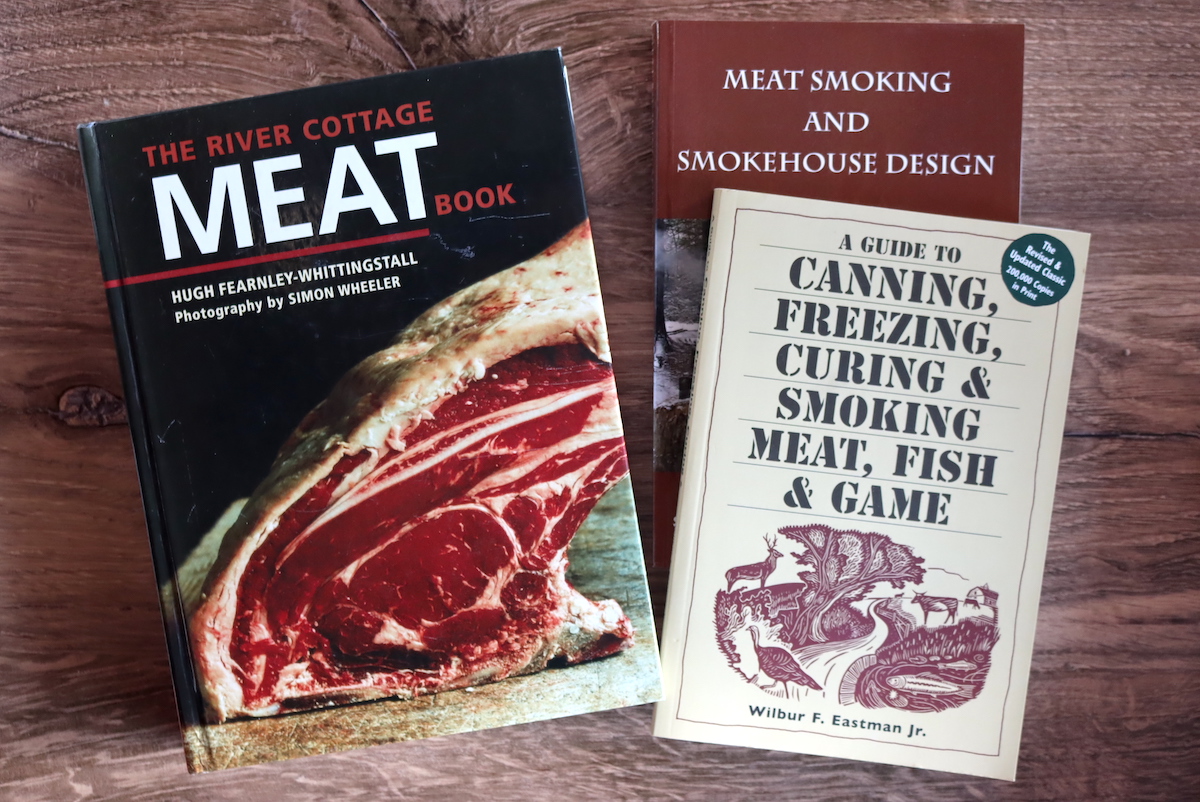
Cheesemaking
Just like charcuterie, cheesemaking can be simple and easy…or it can be incredibly complex and detailed.
It all depends on how deep you want to dive into the topic.
Easy cheese making recipes can be made at home in under an hour, things like mozzarella, ricotta and paneer, and they’re the perfect place to start for beginners.
Later on, if you’d like, you can dive into aging cheese and more complex recipes, but that’s always optional.
Either way, I’d suggest starting by reading my beginners guide to cheesemaking, and then investing in some of these beginner books:
- Home Cheese Making by Ricki Carroll ~ The original beginners guide that started the modern home cheesemaking revolution. If you’re looking for a single beginner’s guide to get started, this is it.
- Artisan Cheese Making at Home by Mary Karlin ~ Though she does have a lot of advanced recipes in here, I still think this is a good guide to getting started with cheesemaking (especially if you hope to progress to more advanced recipes).
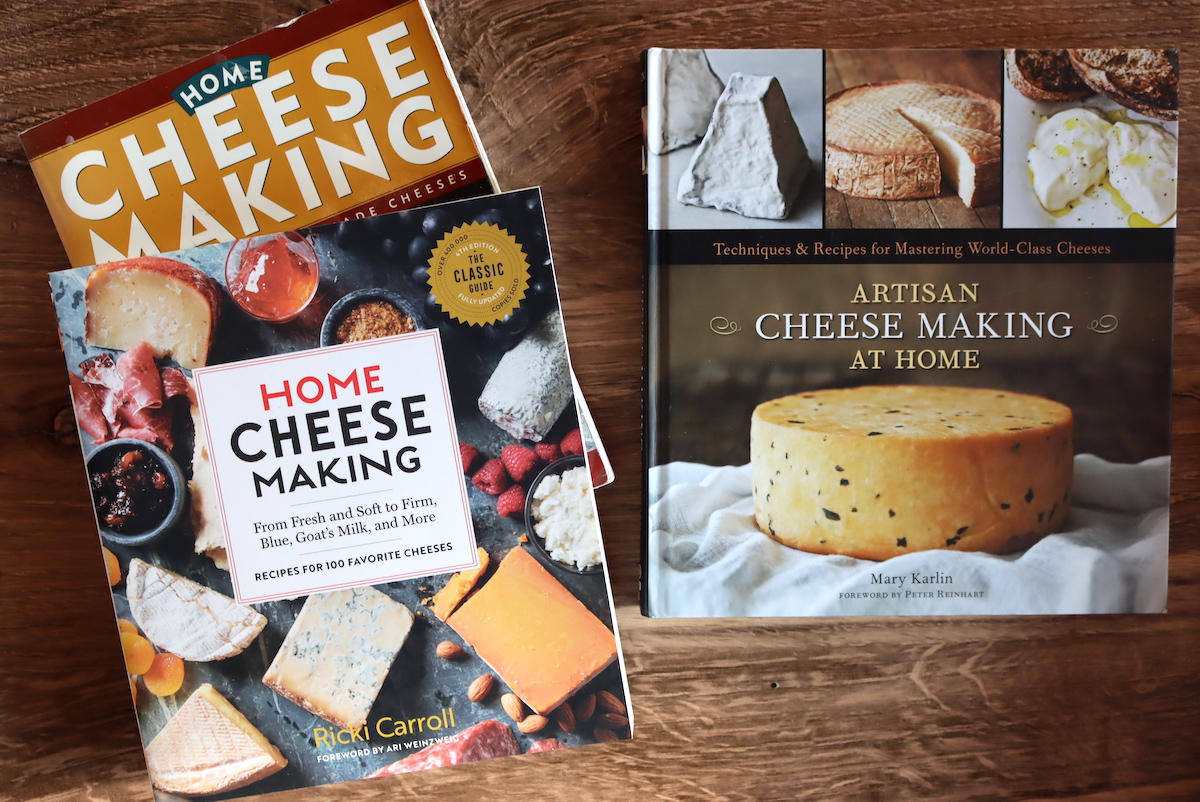
After you’ve mastered beginners recipes and want to take it a step further, I’d recommend these Intermediate and Advanced Cheese making books:
- The Art of Natural Cheesemaking by David Asher ~ More of an intermediate cheese making book, the author teaches you how to make cheese using traditional methods and wild cultures. If you want to make cheese the old fashioned way, with raw milk and no store bought cultures, then this is an incredible resource.
- Mastering Artisan Cheesemaking: The Ultimate Guide for Home-Scale and Market Producers by Gianaclis Caldwell ~ An incredible guide that really dives deep into the “why” of cheesemaking. It’s less a recipe book, and more a technical book that will allow you to understand what’s happening in the cheesemaking process start to finish for just about every style of cheese.
- Successful Cheesemaking: Step-by-Step Instructions and Photos for Making Nearly Every Type of Cheese by Merryl Winstein ~ A two volume spiral bound set, this is a literal textbook on how to make every type of cheese (with pictures). It’s often quite hard to find, and usually sells for over $100. It’s an incredible resource for advanced cheese making.
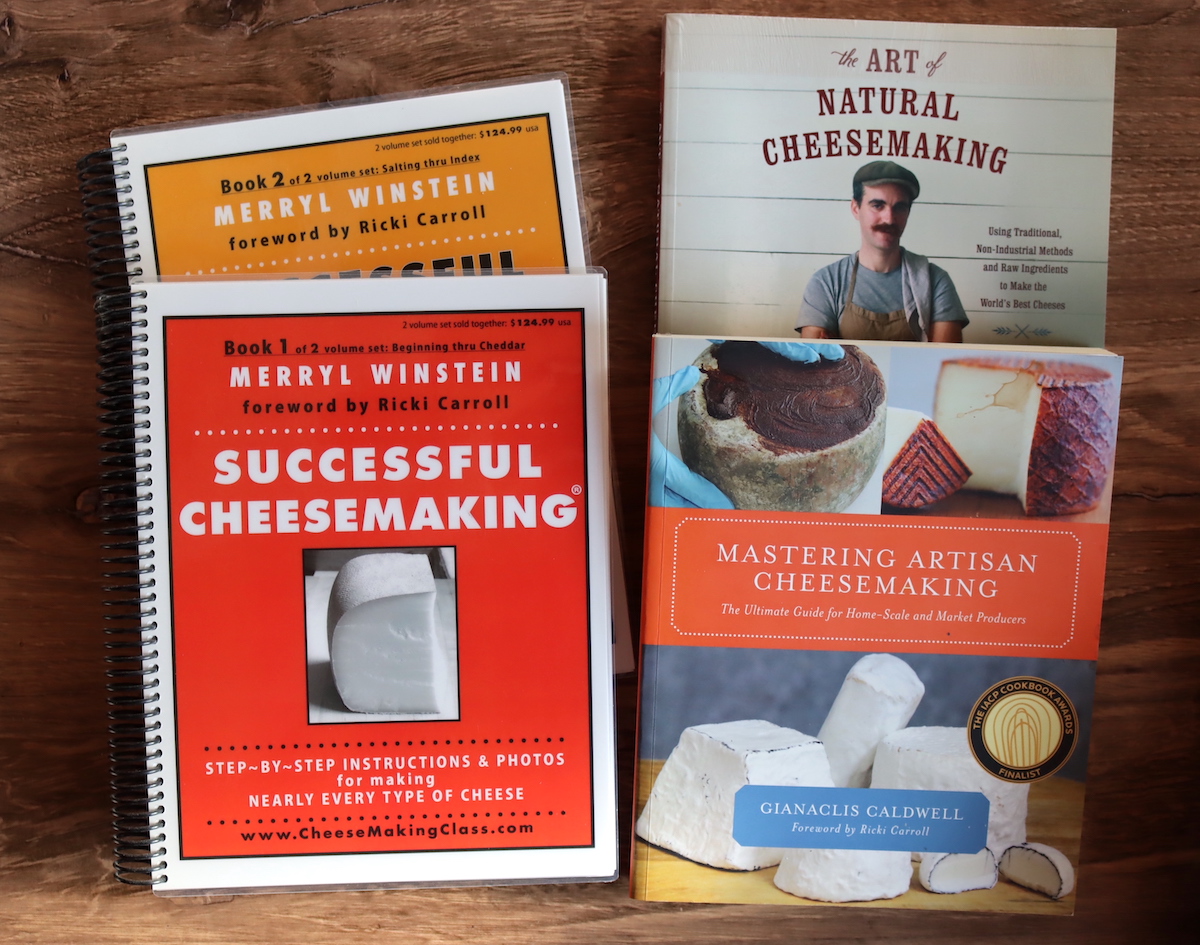
Dehydrating Books
Food dehydration is one of the oldest methods of preservation, and while the principles have remained unchanged for millennia, the tools available these days make the process much easier.
Beyond that, there are literally hundreds of dehydrator recipes that allow you to preserve whole meals (rather than just single ingredients).
I use a 9 tray excaliber dehydrator, and it allows me to put up big batches of food at home quickly and efficiently.
- Preserve It Naturally ~ This is the manual that comes with an Excaliber dehydrator, and it includes temperatures and timetables for dehydrating almost anything under the sun. No prepared food recipes, but exactly what you need to put up fruit and produce from the garden (meat and jerky too).
- The Complete Dehydrator Cookbook by Carole Cancler ~ Literally hundreds of recipes for preparing meals and snacks in your dehydrator, just about anything you’d want to prepare in a dehydrator (beyond just preserving single ingredients).
- Rehydration Calculations Made Easy by Wanda Bailey Clark ~ Everything you need to know to substitute dehydrated (or freeze dried) food into your recipes.
Be aware that dehydrating is a bit different than freeze drying food, which requires a different freeze drying appliance. Sadly, there aren’t any good books on freeze drying, but the machines come with good home manuals.
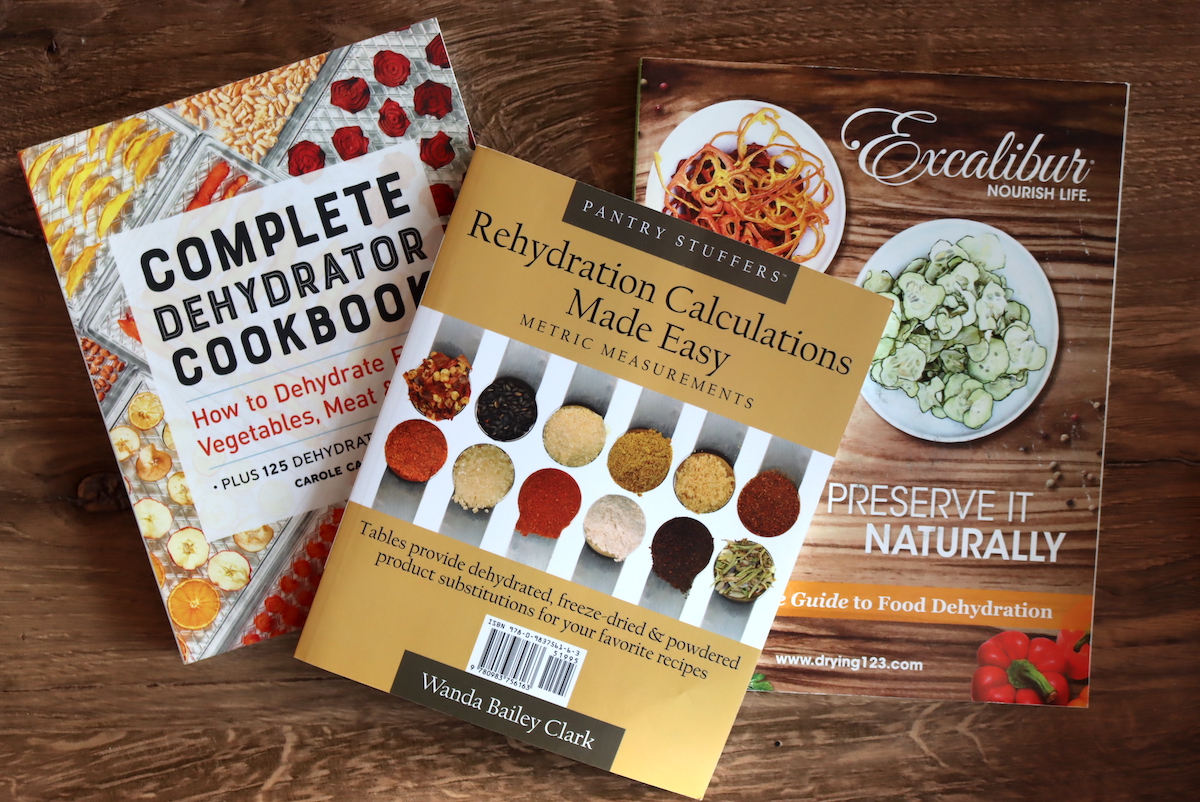
Homebrewing Books
We’ve been making homemade beer for more than a decade, and have literally hundreds of batches under our belts. Still, there are a few homebrewing books that we refer to again and again.
They’re ideal for beginners, but you’ll need them on hand a decade later.
- The Joy of Home Brewing by Charlie Papazian ~ The most popular beginner homebrewing book, this one covers the basic steps of homebrewing beer, and has a lot of beginner recipes. Unfortunately, it doesn’t tell you a lot of the “why” different steps are important. Good to get started, but you’ll need the next book if you really want to understand what’s happening. (If you don’t care why it works, and you just want to follow a recipe to make beer, then you’re good with just this one.)
- How to Brew by John Palmer ~ A really good basic intro, including all the steps. I love this one because it explains why you do each step, as opposed to other books that just provide the steps with no context or rational. It provides a solid foundation, that will allow you to design your own recipes later since you’ll understand the principles of brewing beer at home.
- Brewing Classic Styles by Jamil Zainasheff and John J. Palmer ~ This contains one recipe for every classic beer style: IPAs, Porters, Lagers, Sour Ales, Milk Stouts and many more. Really, any style you’d want to make, you’ll find a recipe here. Each recipe has won awards at brewing competitions, and it’s the perfect base if you want to try developing your own recipes (or just make a great beer in any style).
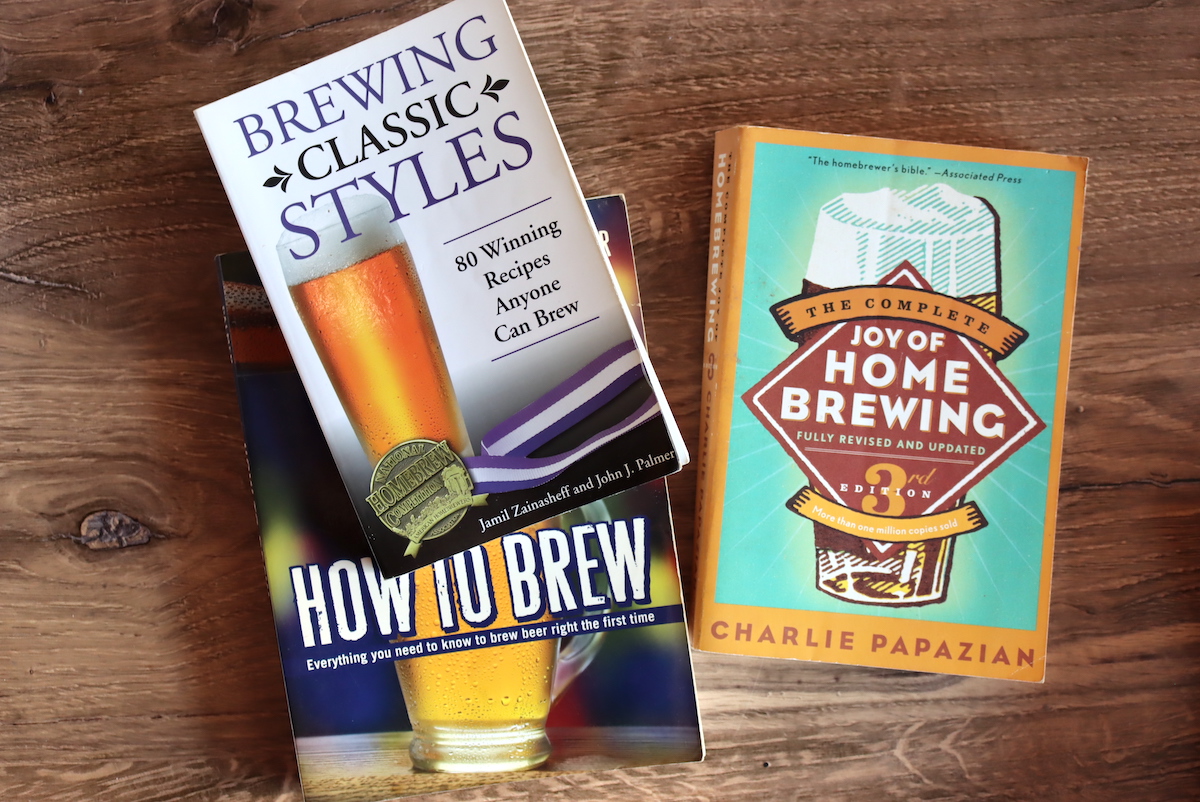
Winemaking (& Mead Making) Books
Winemaking can be just as technical as home brew beer, and depends even more on the quality of the ingredients.
While most people are familiar with grape wines, you can actually make old fashioned country wines out of just about any fruit (and some vegetables too).
Mead is similar, but it’s a honey wine that uses honey to feed the yeast. Honey gives the drink incredible body, and unbelievable flavor. I’d take homemade mead over wine any day.
- Artisanal Small-Batch Brewing: Easy Homemade Wines, Beers, Meads and Ciders by Amber Shehan ~ A great general purpose guide that will get you brewing right away with minimal equipment and ingredients that are already waiting in your pantry. She focuses on natural winemaking, without winemaking additives, so the recipes are simple and cost effective. I made a truly spectacular lemon balm mead using her recipe.
- The Home Winemakers Companion by Ed Halloran ~ The best all around manual I’ve found for making fruit wines. He covers techniques for grape wines as well as country wine with other fruits, and many of my winemaking recipes are adapted from this book (including this recipe for blueberry wine).
- The Joy of Home Winemaking by Terry Garey ~ A bit more conversational and less technical than The Home Winemakers Companion, this one might be more accessible to the casual winemaker. It has hundreds of recipes, far more than any other winemaking book I’ve seen. It also has some of the most creative recipes by far.
- The Compleat Meadmaker by Ken Schramm ~ The difinitive guide to making homemade mead using modern methods.
- Make Mead Like a Viking by Jereme Zimmerman ~ Techniques for brewing traditional meads with minimal equipment and no additives, as they were brewed thousands of years ago.
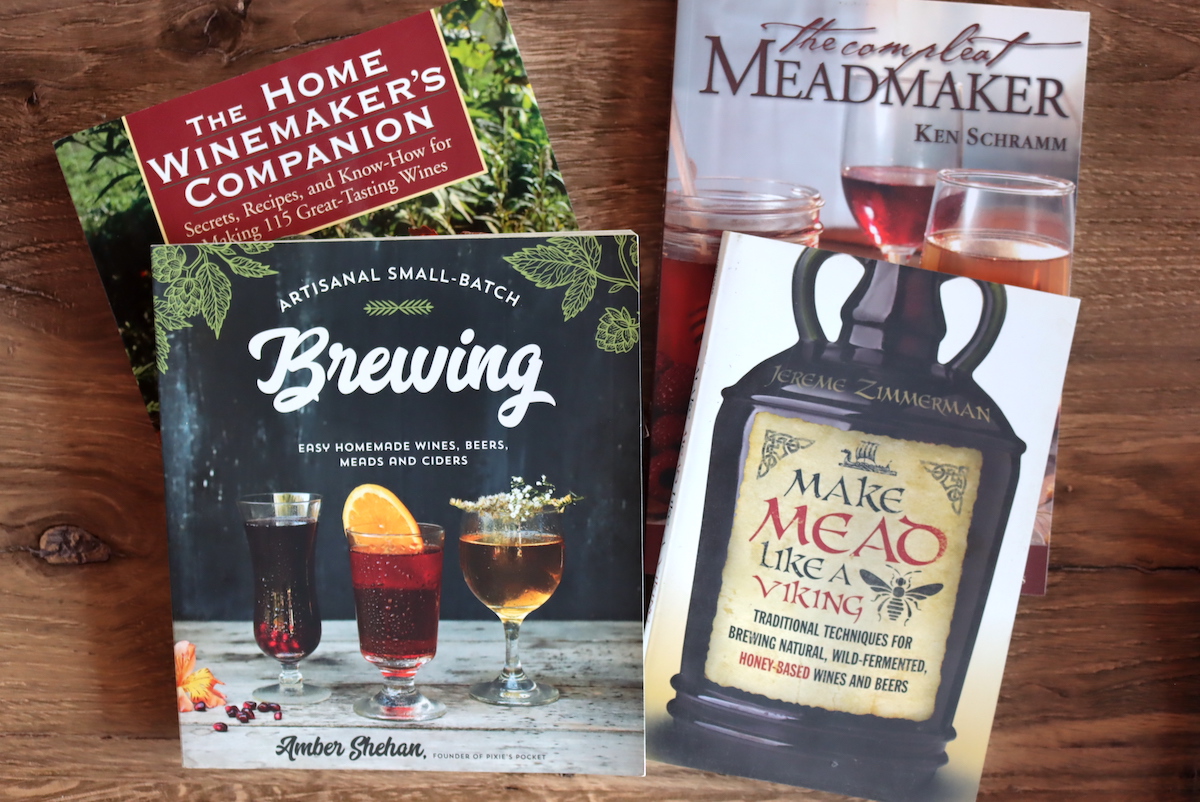
Beyond that, if you’re a complete brewing nerd like I am, you’ll also really appreciate these historical brewing books.
They really dive deep into the history of brewing, some including recipes and techniques reconstructed from archeological digs dating back as far as 9,000 BC.
- Sacred Herbal Healing Beers: The Secrets of Ancient Fermentation
- Historical Brewing Techniques: The Lost Art of Farmhouse Brewing
- Viking Age Brew: The Craft of Brewing Sahti Farmhouse Ale
- Ancient Brews: Rediscovered and Re-created
- 18th and Early 19th Century Brewing
If you happen to be a forager, The Wildcrafting Brewer is a good way to combine both your hobbies.
Herbalism Books
Herbal medicine is a huge topic, covering literally thousands of medicinal plants and dozens of types of herbal preparations for just about every condition under the sun.
Beginner herbalist books will teach you how to use common medicinal plants to treat everyday issues. They’re the perfect place to start your herbal journey.
- Backyard Medicine by Julie Bruton-Seal ~ If you only choose one beginners book, this is the one. Perfect for the absolute beginner looking to harvest medicine from commonly available backyard plants.
- The Backyard Herbal Apothecary: Effective Medicinal Remedies Using Commonly Found Herbs & Plants by Devon Young ~ Well written and accessible, the author goes into using commonly available herbs to create specific herbal remedies.
- The Boreal Herbal by Beverley Gray ~ A great guide for wild foraged herbal remedies if you live in Northern laditudes. Just about everything listed grows locally here in Vermont, and it’s one of my favorite guides. Not that helpful if you live in the south though.
- The Herbal Apothecary: 100 Medicinal Herbs and How to Use Them by JJ Pursell ~ A large herbal apothecary book, covering the preparation and uses of, as the name says, 100 different herbs. Comprehensive, but perhaps overwhelming for a beginner.
- Grow Your Own Herbal Remedies by Maria Noel Groves ~ The perfect guide for the home gardener looking to add herbal remedies to their garden plot.
Beyond books, I’d also recommend a number of courses by the Herbal Academy, and I’ve taken almost all of them. I have the textbook book set from their Intermediate Herbal Course and it’s really quite handy.
They also have specific courses covering all manner of topics. These are the ones I’ve taken:
- Introductory Herbal Course
- Intermediate Herbal Course
- Making Herbal Preparations
- Botanical Skin Care
- Herbal Formulation
- Herbal Fermentation
- Herbal Self Care for Stress Management
- Foraging Course
- Botany and Wildcrafting Course
- The Mushroom Course
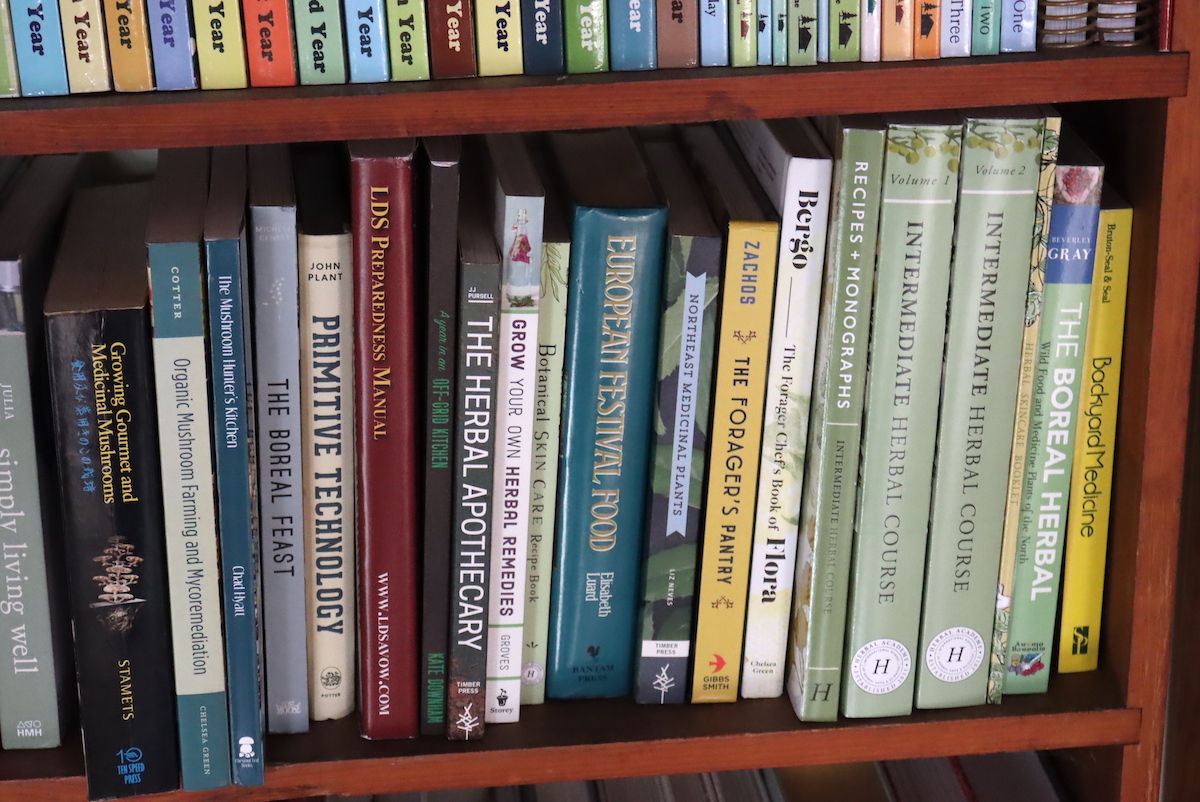
Foraging and Wild Food
Wild food and foraging guides are often really regionally specific, as plants vary from place to place. My favorites are actually more generalist foraging books, that cover plants with wide ranges so they’re applicable across most the US.
Of all the foraging books I’ve read, by far the best ones are by Sam Thayer. He has three books:
- The Foragers Harvest by Sam Thayer
- Natures Garden by Sam Thayer
- Incredible Wild Edibles by Sam Thayer
Beyond specific foraging guide books, there are also foraging recipe books. They cover not only how to prepare the foods, but also usually go through the plants range and identification.
They’re a good way to find new plants, and with recipes, they really inspire you to get out there and find the wild foods.
- The Forager Chef’s Book of Flora by Alan Bergo
- The New Wildcrafted Cuisine by Pascal Baudar
- Forage Harvest Feast by Marie Viljoan
- The Forager’s Pantry by Ellen Zachos
Mushroom Books
Whether you’re interested in growing mushrooms at home, or foraging wild mushrooms, these are particular good guides.
- Organic Mushroom Farming and Mycoremediation by Tradd Cotter ~ The only resource you’ll ever need if you plan on growing mushrooms at home, regardless of the variety. Indoor or outdoor, small scale or commercial scale, he covers everything. The author also covers foraging common wild species as well, both edible and medicinal.
- Growing Gourmet and Medicinal Mushrooms by Paul Stamets ~ Definitely a technical book, and an incredibly dense read, but it’s hard to beat this volume for information regarding mushroom cultivation. The book by Tradd Cotter above is a lot more accessible for the average reader though.
- Mushrooms Demystified by David Arora ~ One of the best mushroom foraging guides available.
Homestead DIY and Craft Books
I’ve actually found general DIY books are rarely worth the money, but there are a few.
- Projects for Self Sufficiency ~ This has over 50 projects, all of them practical and useful around the homestead. We’ve made several, including their compost sifter and their apple storage rack for our basement root cellar.
- The Razor Edge Book of Sharpening by John Juranitch ~ If you don’t think the art of knife sharpening needs a whole book, then you’re probably doing it wrong. This is everything you need to know about the topic, and it’s well written.
- Caveman Chemistry: 28 Projects from The Creation of Fire to The Production of Plastic by Kevin Dunn ~ This really is a “back to basics” DIY manual, and I mean really back to basics. Making your own lye for soapmaking, homemade paper, batteries, ceramics…you name it. It explains the chemistry of each, and how you can make it at home with rudimentary things from the environment. A great home school project book, and fun for hardcore DIY adults too.
Metalworking & Blacksmithing
My husband is particularly interested in metalworking and blacksmithing, and we have quite the home workshop here on our homestead.
These are the books he recommends for beginners, and they were incredibly helpful to him when he was starting out.
- Build Your Own Metal Working Shop from Scrap by David Gingery ~ Walks you through the complete process of building a complete set of metalworking equipment from scratch, using only hand tools. Starting with casting, then building a drill press, a lathe, and more. Building your own metal shop step by step with nothing more than hand tools will teach you all the skills you need to know to actually use your home built metal shop once you’re done. I love his can do attitude, and the author did this all by himself in the 1950’s in a small backyard shed.
- The Complete Modern Blacksmith by Alexander Weygers ~ Everything you need to know to get started with home blacksmithing.
Home Building & Carpentry Books
If you’re looking to build your own home, these resources cover the best techniques for doing it right.
Even if you’ve got a lovely home already built, it’s always nice to know how to build your own outbuildings, goat barns and chicken coops.
Personally, we’re reading up on cobb building techniques so we can put in a wood fired sauna down by our pond. Outbuildings don’t have to just be limited to chicken coops…
- The Natural Building Companion by Jacob Racusin and Ace McArleton ~ Experts in cutting edge natural building techniques, Jacob and Ace take you through modern green building practices for building tight, energy efficient and spectacularly beautiful homes. The cover cobb, natural plasters, timber framing and more. Their building company actually did work on our home, long before this book was written and they really know their stuff.
- Polyface Designs: A Comprehensive Construction Guide for Scalable Farming Infrastructure by Joel Salatin ~ All the designs for farm buildings, chicken tractors and pig-mobiles from polyface farm. Really a great resource if you plan on raising animals in a natural way.
- Building Small Barns, Sheds and Shelters by Monte Burch ~ A basic guide to building homestead outbuildings.
- Building a Homestead Root Cellar by Teri Page ~ A step by step guide to designing and building your own root stand alone root cellar of poured concrete.
Off-Grid Living Books
These books are about living an off grid lifestyle, and less about the specifics of alternative energy.
Before you make the jump to living off grid, re-skilling and determining whether or not you actually want to live this life is a lot more important than understanding the specifics of how solar/wind/hydro power works.
If you go through these and realize it’s the life for you, in the next section I’ll cover alternative energy books.
- The Do-able Off Grid Homestead by Sharon Stronger ~ Sharon lives in a 100% hand built off grid homestead in Texas, and her family has done everything from the ground up on a tight budget. If you don’t have a lot to spend, you really want to read this one before trying to go off grid.
- Creating Your Off Grid Homestead by Teri Page ~ Teri’s book covers how she setup her off grid homestead from scratch, and has a lot of information I wish I would have known before moving off grid. This one is only available as an e-book.
- A Year in an Off Grid Kitchen by Kate Downham ~ More of a cookbook for off grid homes homesteaders, Kate teaches you how to cook on a wood cook stove, preserve food and put garden fresh food on the table.
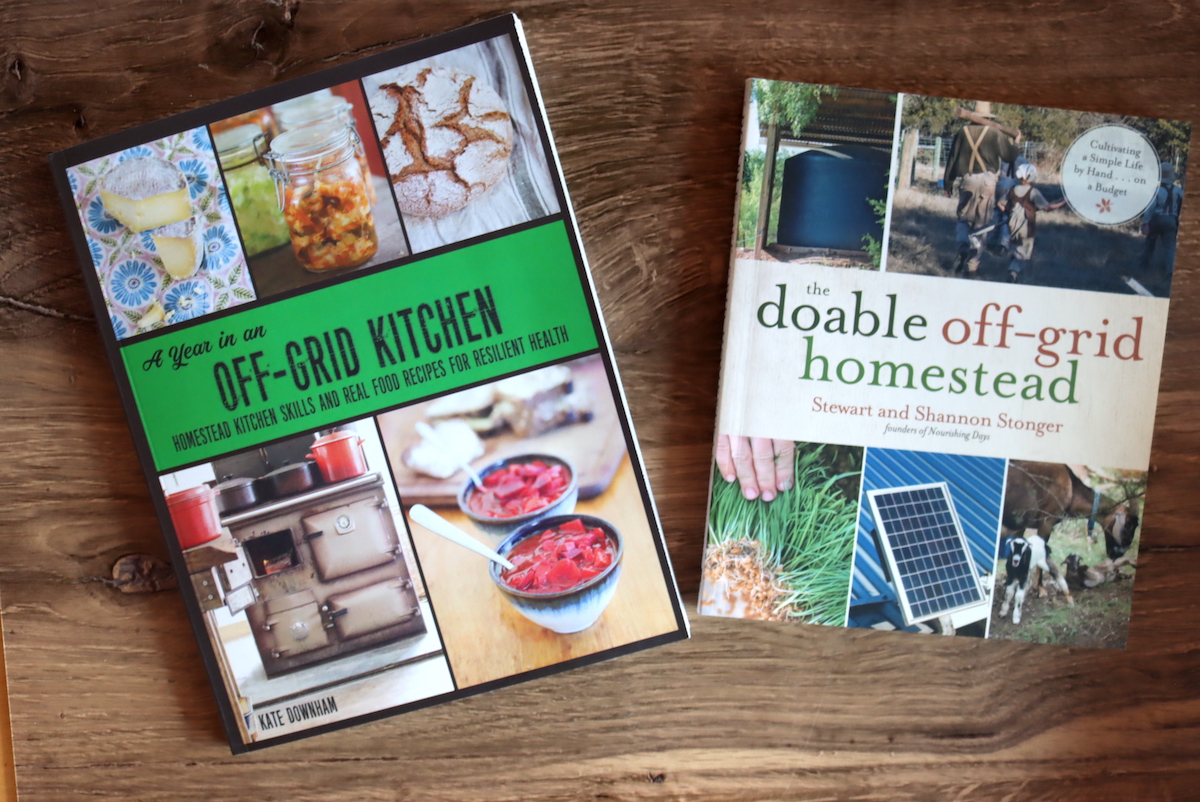
Alternative Energy Books
While living off the grid can be a lifestyle, pursuing alternative sources of energy is an engaging (and potentially useful) hobby in itself.
These books cover the basics of setting up a solar powered system, but I’ve also included a number that explore other types of alternative energy.
- Alternative Energy Secrets by Stephen Chastain ~ I know the title sounds horrible and spammy, but this is by far the best book on alternative energy technology I’ve found to date. Seriously, hands down the best.
- Generators and Inverters by Stephen Chastain ~ This one I’m reading now, and it looks good. I got it because Alternative Energy Secrets was so helpful, and it’s by the same author. Perhaps a bit dense for the average reader, and is written assuming you’re seriously into DIY.
- The Wood Gasifier Builder’s Bible: Off Grid Fuel for the Prepared Homestead by Ben Peterson ~ He takes you through the process of building a wood gassifier from start to finish. Unfortunately, while he does show you the one he built, he’s a little spotty on the details of how they work in general. Though it’s not the best manual, it’s the best I’ve found on the topic because it actually does have a practical example.
I know, that’s not very many…and I’ve found precious few alternative energy books worth reading. If you have any suggestions, please by all means, leave them in the comments.
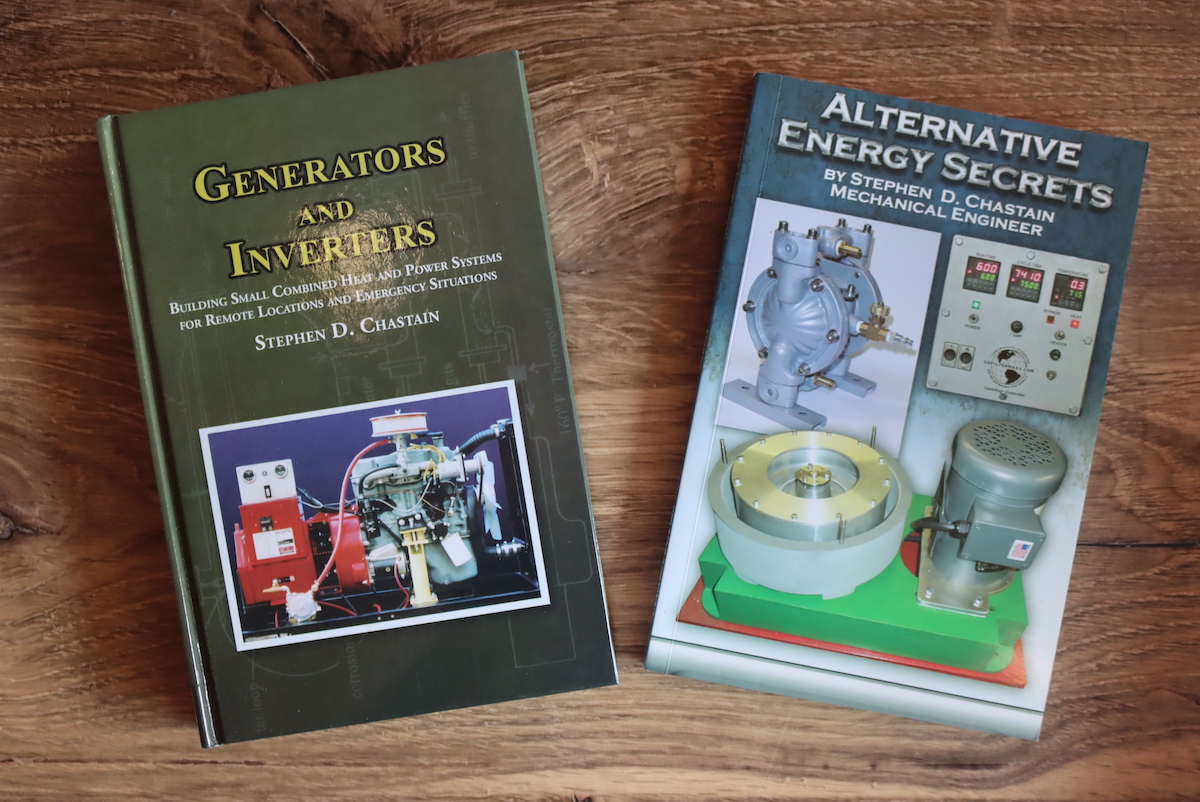
Hunting, Fishing, and Survival Skills
Like alternative energy, my shelf is a bit sparse in this topic as well…as most guides are horribly impractical. They’re all written seemingly by people who have only read about life outside their city apartment, and they’re just trying to make a quick buck.
If you have any recommendations here, I’m all ears.
In the meantime, the best book I’ve found on tracking is below. My kids and I use it all the time, and it’s incredibly useful.
- Tracking and the Art of Seeing by Paul Rezendes
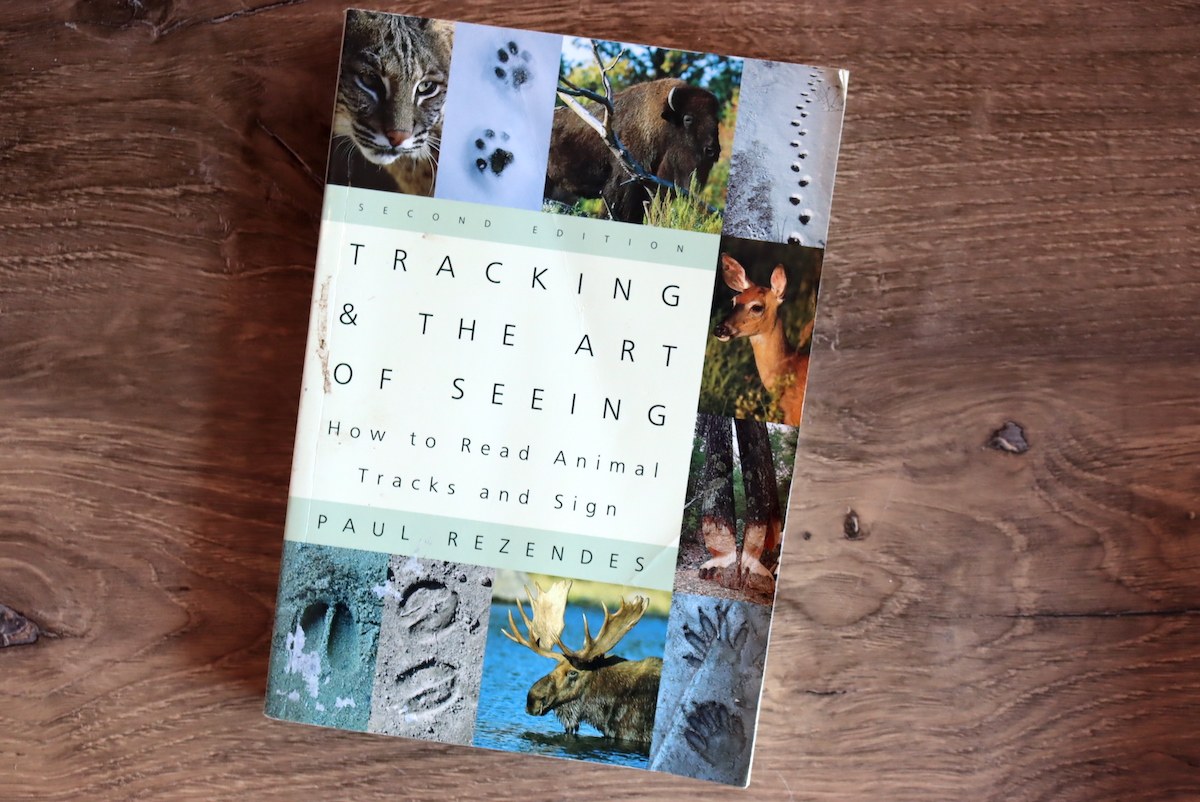
Firearms and Ammunition
Since 2020 firearms ownership has increased dramatically, and I can only hope that all those new gun owners are taking the time to educate themselves on proper firearms handling.
These books cover the basics of firearms handling and marksmanship, in short and long distances. I’ve also included a few reloading books, as ammo is harder to find these days.
- Practical Shooting by Brian Enos ~ The first place to start when learning how to handle a firearm.
- Long Range Shooting Handbook: A Beginner’s Guide to Precision Rifle Shooting by Ryan Cleckner ~ If you want to learn to shoot accuratly down range with a rifle, this is the book to choose.
- The Practical Guide to Reloading Ammunition by Tom McHale ~ A great beginners guide to reloading, in an easy to read conversational tone. It doesn’t have all the information you need to get started, but it does explain the basic principles better than any other book I’ve found.
- Hornady Handbook of Cartridge Reloading ~ Once you understand the principles of reloading, this handbook takes you through all the technical specs to actually get the job done for each type of bullet. It’s a little light on the basic overview, so I’d suggest it along with the one above which lacks all the practical tables that this one contains.
I’ll also call out The Chemistry of Powder and Explosives as a fun read.
It was written by an MIT Chemistry professor in the 1940s and though it’s not exactly a practical manual, it’s good for gun nerds that want to understand what’s going on behind the scenes.
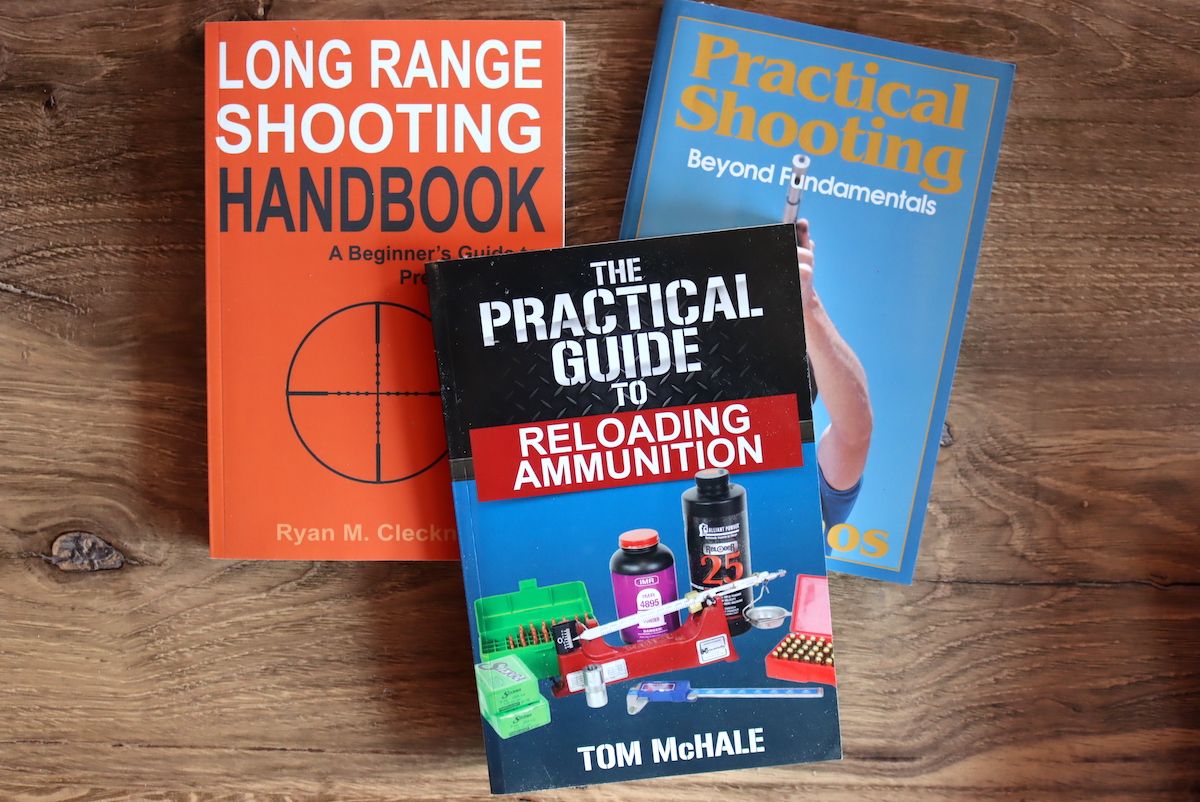
HAM Radio
HAM radio is an incredibly practical way to communicate without modern satellite technology, and it’s a good way to contact other resilient communities (locally or internationally).
You’d be amazed how far a simple HAM radio signal can travel.
In the US, operating HAM radio requires a license, which just ensures you understand the basic principles of how it works before you get on the air. These books cover the basics, as well as how to pass the test.
- The ARRL Handbook for Radio Communications ~ A six volume set, these cover everything you could possibly want to know about HAM radio. It’s not a HAM radio test manual (like below), but it’s all the information that you’d need to pass the test anyway.
- The HAM Radio License Manual ~ A study guide with questions that’s specifically designed to help you study for the HAM radio test. It doesn’t do the best job of explaining what’s going on, see the book series above for that, but it does go through all the possible questions to help you learn the right answers (like an SAT study guide).
Preparedness
I’ll be honest, I’ve found very few good preparedness books. If you really want a “preparedness book” then what you actually need is more or less this whole library.
Just about every “prepper” book has at best a 2 paragraph summary of each of the topics discussed here, along with some incredibly bad advice about treating gun wounds with tampons.
That said, there are a few that are pretty darn decent overall, but they’re the exception, and most are not worth the paper they’re printed on.
Here’s the one’s I’d recommend:
- The LDS Preparedness Manual ~ A curated compilation of preparedness articles on just about every topic, this is by far the best book on general practical preparedness I’ve found to date. Though it’s put out with a Later Day Saints bias, it’s still the best manual, regardless of whether you’re religious or secular.
- The Knowledge: How to Rebuild Civilization in the Aftermath of a Cataclysm by Lewis Dartnell ~ No, this book does not contain everything you need to know to rebuild society, far from it. You’d need several hundred (if not thousand) volumes this size to do that. That said, it does have a lot of really insightful tutorials, and comes up with a lot of things you just wouldn’t think of. It’s not a “manual” but it is a fun read that will make you think about how the world is put together.
- A Year Without the Grocery Store: A Step by Step Guide to Acquiring, Organizing, and Cooking Food Storage by Karen Morris ~ I was sad to learn that the author did not actually go a year without going to the grocery store to write this book. She did, however, write a beginners guide to bulk food storage that’s a great place to start if you’re trying to put up a years worth of food for long term (25+ year) storage without spending a lot of money.
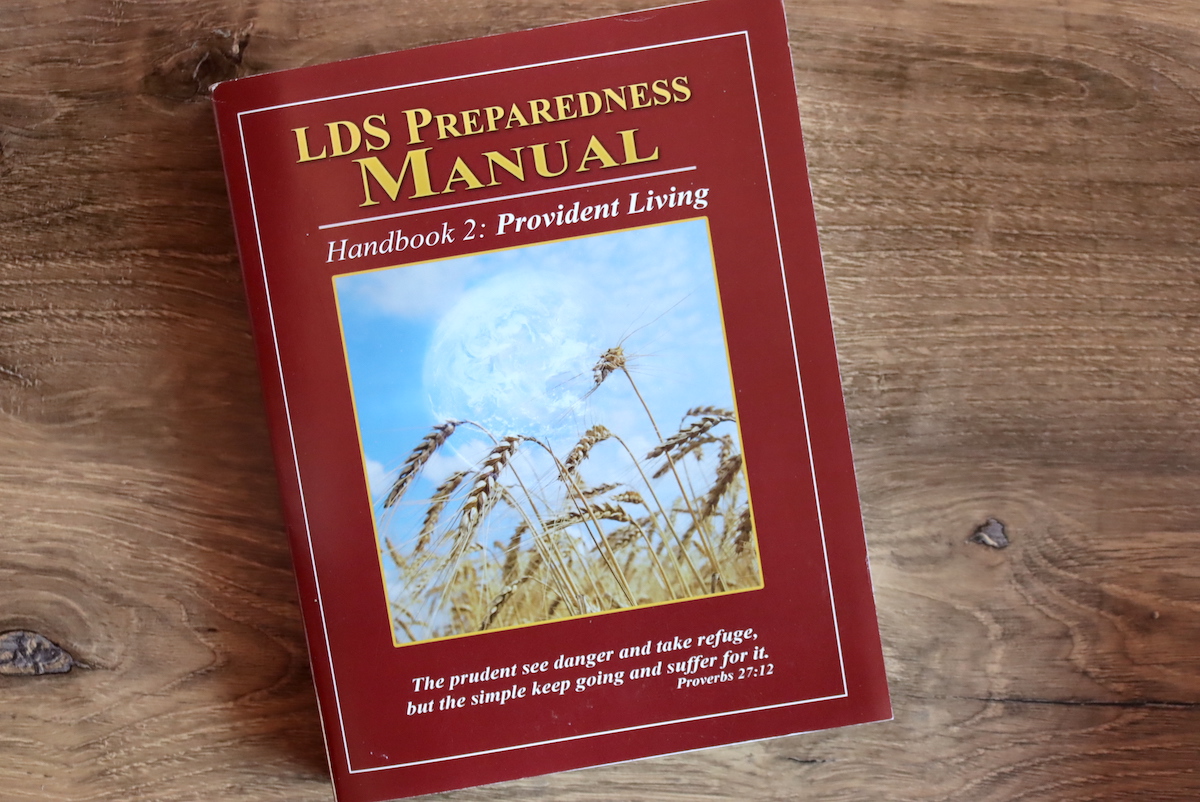
Books for Self Reliance
I know I’ve covered a lot of great Self Reliance Manuals, but I’ve definitely missed some good ones.
I would absolutely love book recommendations, and I encourage you to let me know your favorites in the comments below.
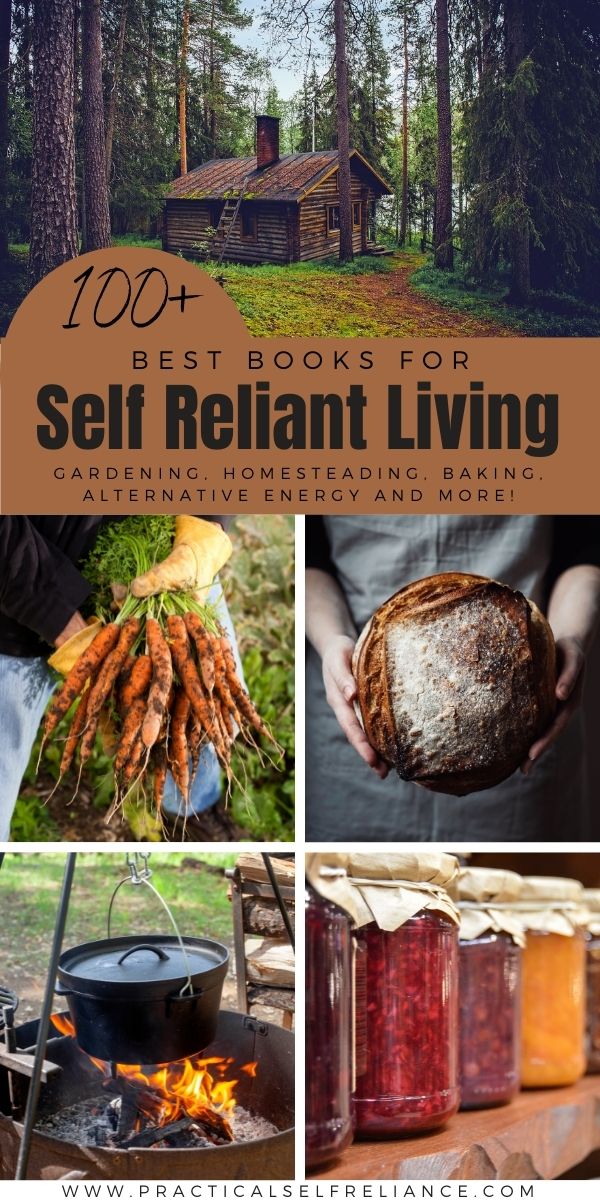
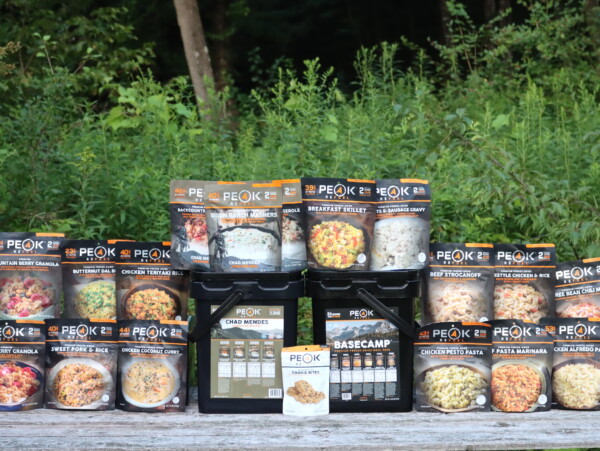
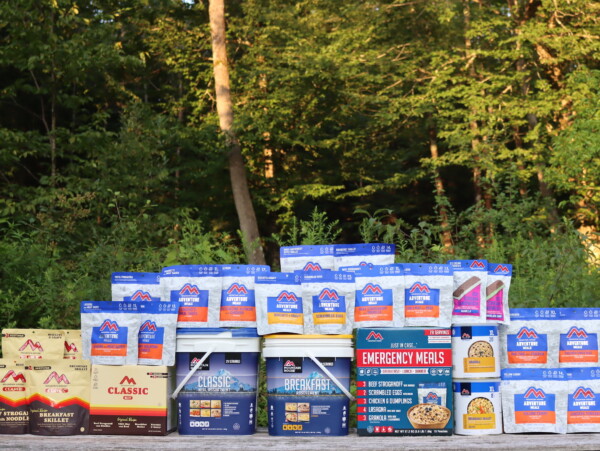
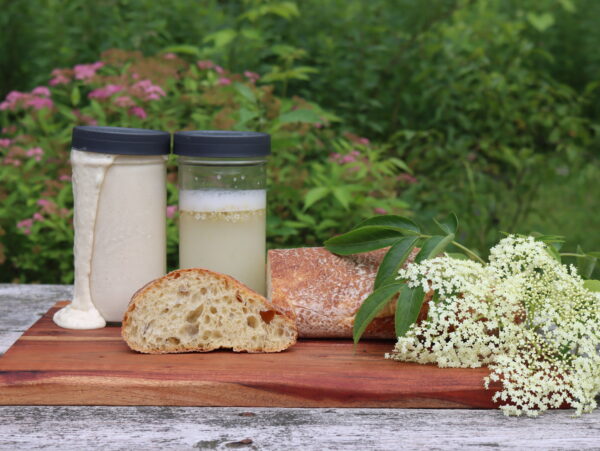
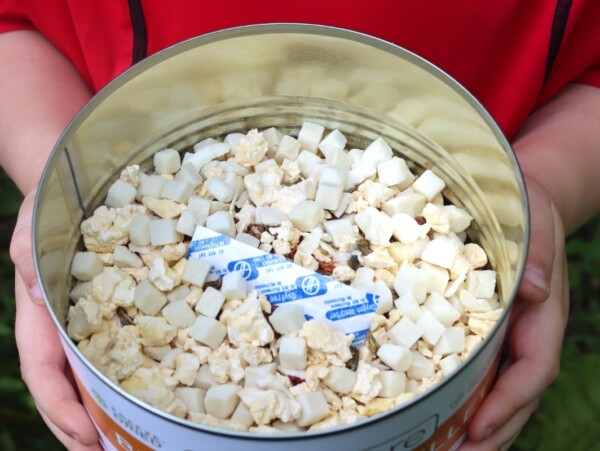
Personally as far as seed saving goes I found Seed to Seed boring. I much prefer “The Heirloom Life Gardener” by Jere Gettle owner of Baker’s Creek.
Debbie In MA
I love Baker’s Creek but I haven’t read that one yet. I’ll have to check it out. Thanks for the suggestion.
In response to the comments about Information on textiles: there is a quantity of advice on the internet on best books for beginners. I would add that Edward Worst’s book – Foot-Power Loom Weaving – is public domain and is available from the Library of Congress website at https://tile.loc.gov/storage-services/public/gdcmassbookdig/footpowerloomwea01wors/footpowerloomwea01wors.pdf. I don’t think his is the best book on learning to weave, but he has detailed plans for two different floor looms as well as many, many useful accessories. And also a fairly extensive section on dyeing cloth. Anyone who wants a floor loom should look into buying a used one, though. These big looms MUST be made out of hardwood to stand the tension necessary, and hardwood is expensive and more difficult to work with than softwoods. Don’t expect to weave all the cloth for your family’s clothes…
Note that Worst’s book was reprinted under the revised title “Weaving with Foot-Powered Looms” in the 1970’s and that version is NOT public-domain. It’s the same text, as far as I can tell.
Thanks for sharing.
For practical prepping, without the obsession about survival bunkers and guns, I suggest Jack Lawson’s 2-book “Civil Defense Manual”, based loosely off the Civil Defense training manuals that every state had up through the 1970’s, only updated for the modern age. It features topic-articles written by credible experts, such as food storage, medical emergencies, storing and purifying water, etc. But the most USEFUL part of the manual is the suggestions on how to delicately scope out your neighbors to figure out who you might want to recruit into your new “emergency preparedness group” (i.e., your “survival group”), who maybe you don’t want “in” on the group because they aren’t preparedness minded, but they have important skills (such as gardening or a chainsaw to cut up downed trees), and how to identify who you want to pay a wide berth and be wary of in an actual SHTF grid down situation. It discusses how to “feel people out” and get them working together without coming right out and stating you’re starting a prepping club.
https://civildefensemanual.com/
Thanks for sharing. This sounds like a great resource.
If you wrote a book I would read it!
Ha! I get that a lot =). Maybe someday when my kids are older, but not anytime soon!
Thank you so much for sharing all these books – such an amazing wealth of information.
You’re very welcome.
Thank you so much for writing this. I’m looking for information on all of these subjects and the market is has so many books that it’s hard to decide which is really going to be helpful. I don’t have a lot of space for a large library and it’s nice having a list of must haves and an explanation of why from someone actually living this lifestyle . Very helpful.
You’re very welcome. I’m so glad it was helpful for you. Another great tip, if you have a local library is to check out the books before purchasing them to be sure that it’s a book that you would want to keep on your shelf.